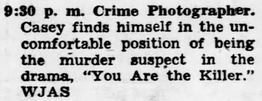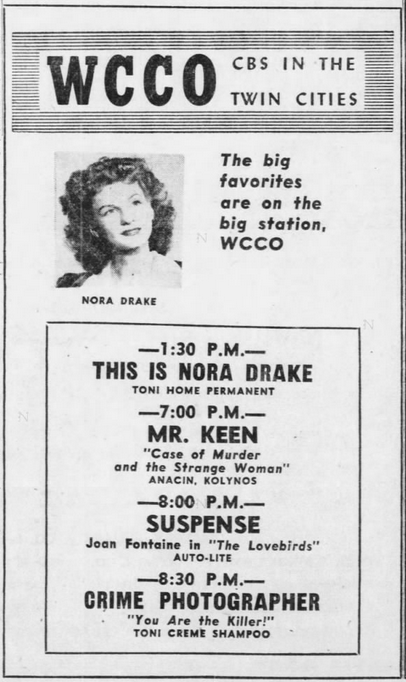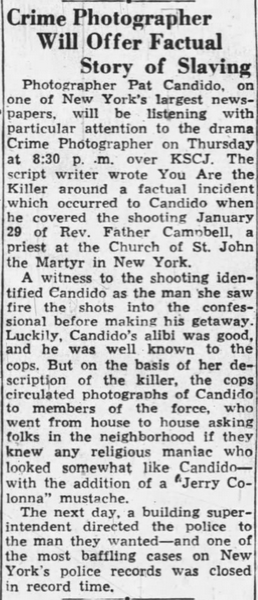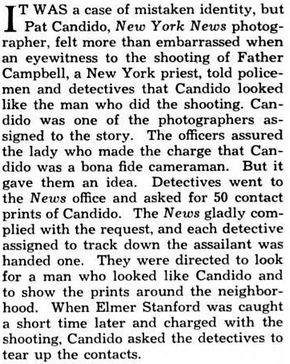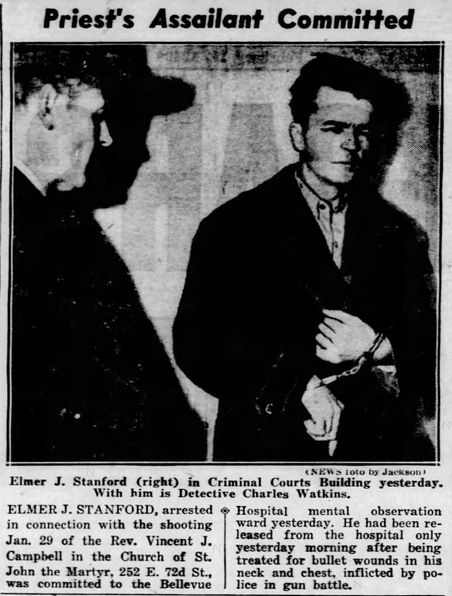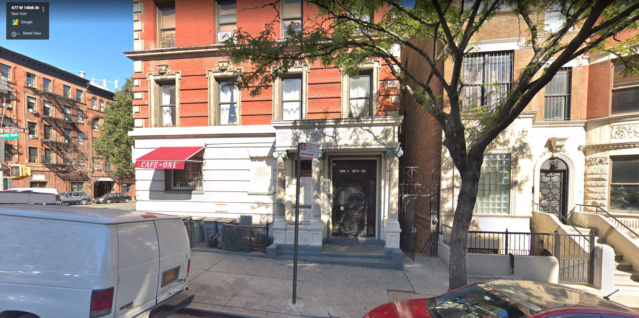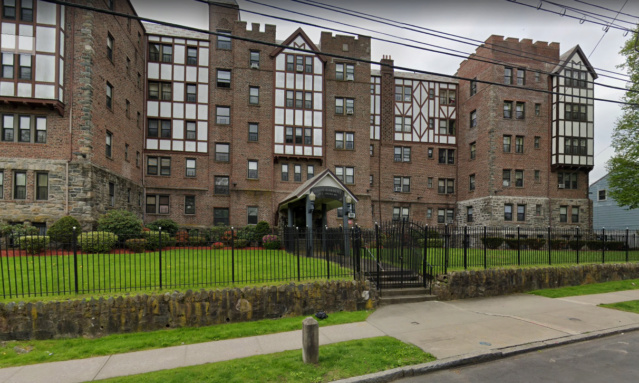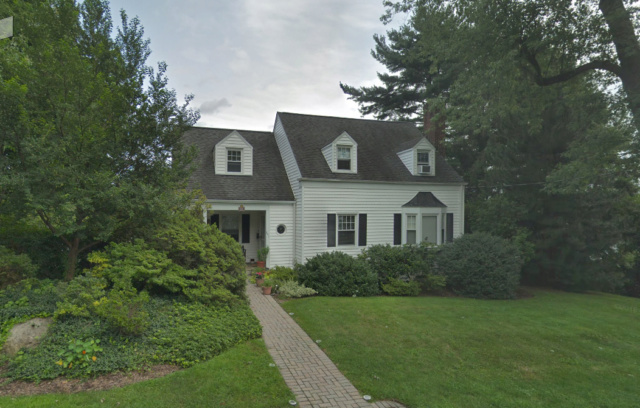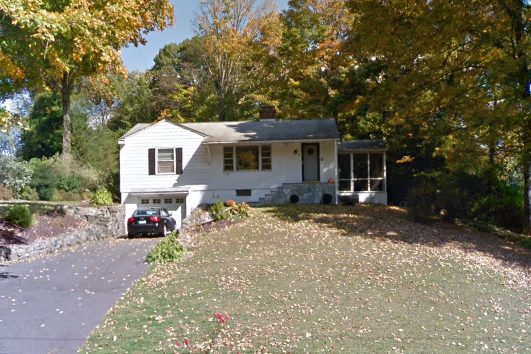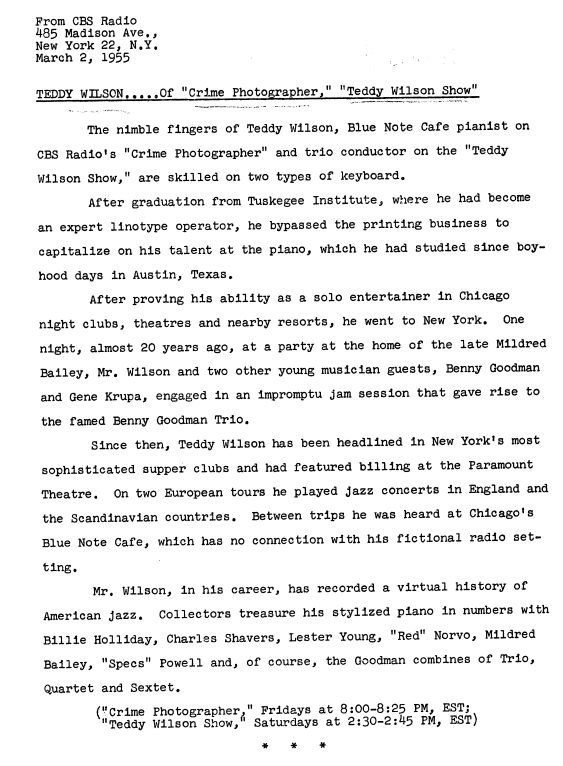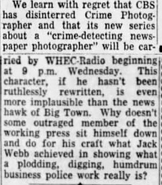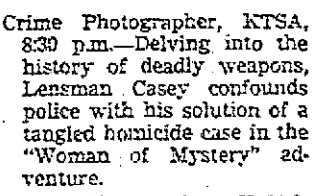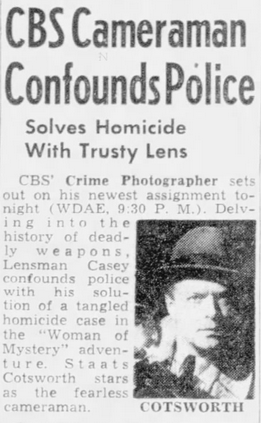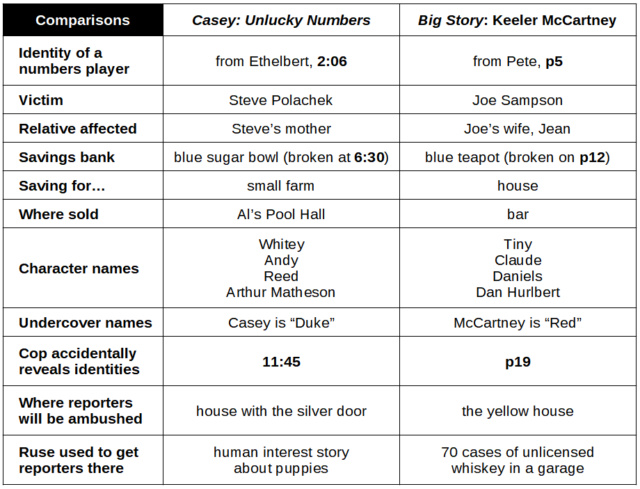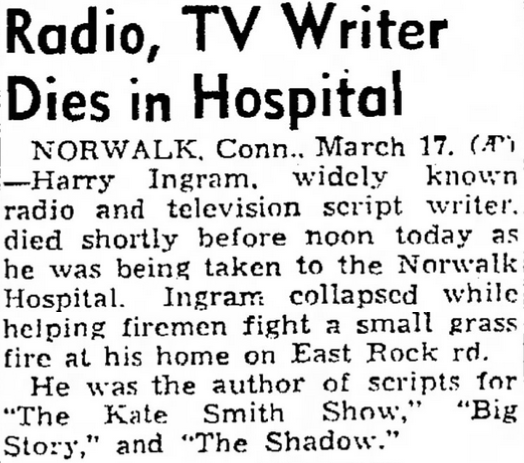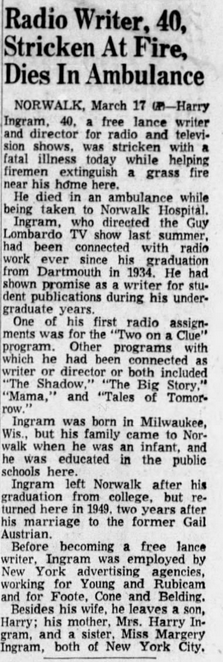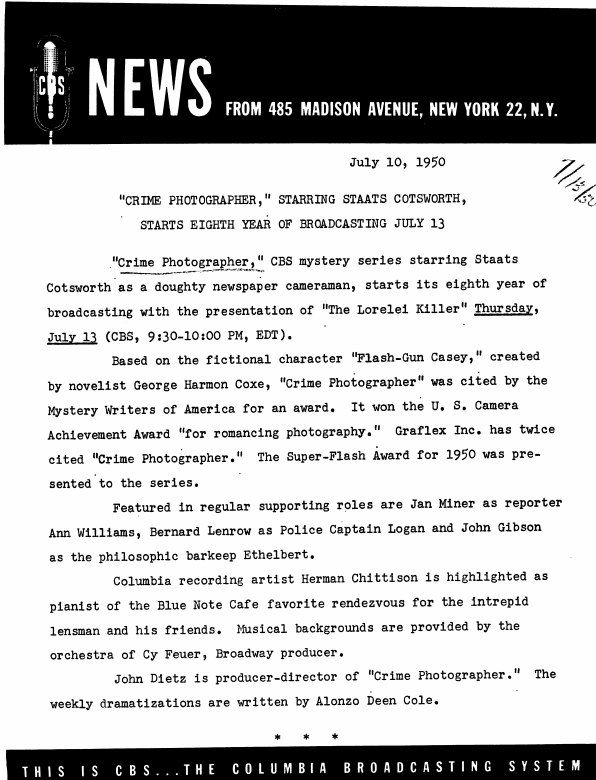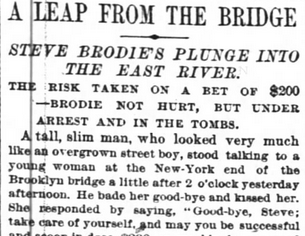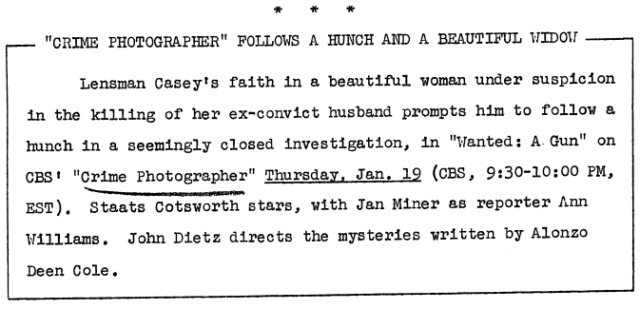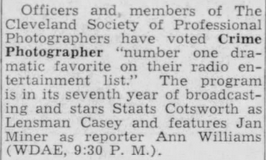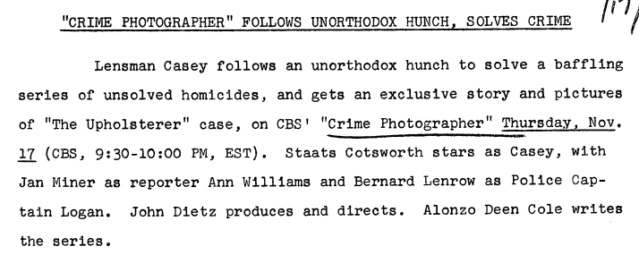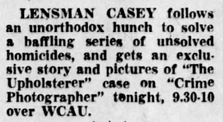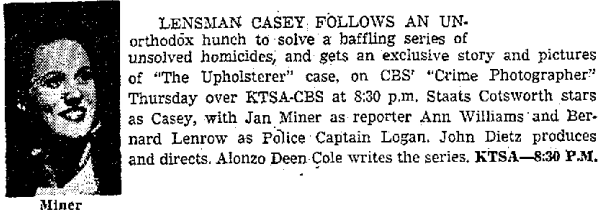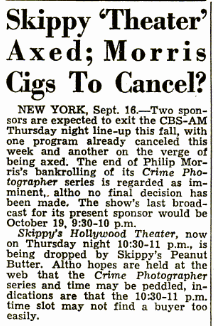An updated log of the series is now available. It is a 13-page PDF. DOWNLOAD
It is in spreadsheet format and identifies all of the repeated uses of scripts that the series had, far more than anyone had previously suspected.
An online spreadsheet can be viewed with this link. It can be downloaded in multiple spreadsheet formats for Microsoft Excel (.xlsx) and Open Document Format for spreadsheets in LibreOffice and OpenOffice (.ods).
Deconstructing one of radio's most beloved series, "Casey, Crime Photographer," on an episode-by-episode basis. The series ran on CBS 1943 to 1950, then 1954 to 1955. The "Blue Note Cafe" is where Casey, Ann Williams, and Ethelbert the bartender can always be found pondering the latest mystery and the meaning of life. View posts chronologically from the "1943-07-07 Case of the Switched Plates" (posted January 2020) and then forward so commentary rolls out in the most logical way.
1949-03-03 You are the Killer (not in circulation; an episode based on a real event)
This is an interesting side story about a Toni-era program that is missing. It's You are the Killer broadcast on March 3, 1949. It's the only Casey that I have found that is drawn from a real life news story.
These are the ADC continuity notes for the episode:

This is the CBS press release:
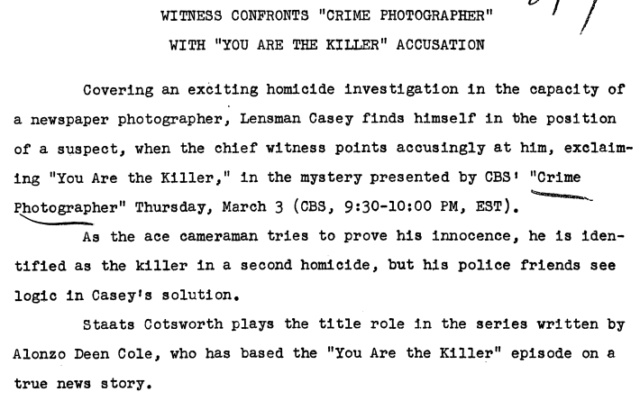
These are clips for the episode:
This was one of those situations where I stumbled on the entire story by accident. I've even forgotten the specifics of what I was originally searching for!
This is the clip that sent me exploring... the photographer mentioned is Pat Candido of the New York Daily News.
Pat tells the story to Popular Photography magazine.
This is the news story behind it. A crazed man shoots a priest hearing confessions. The priest is shot in the leg and survives. Cole changes the story to a judge and makes some other adjustments.
This is some of the original NYDN coverage.
1949-01-30
These are the ADC continuity notes for the episode:

This is the CBS press release:

These are clips for the episode:
This was one of those situations where I stumbled on the entire story by accident. I've even forgotten the specifics of what I was originally searching for!
This is the clip that sent me exploring... the photographer mentioned is Pat Candido of the New York Daily News.
Pat tells the story to Popular Photography magazine.
This is the news story behind it. A crazed man shoots a priest hearing confessions. The priest is shot in the leg and survives. Cole changes the story to a judge and makes some other adjustments.
This is some of the original NYDN coverage.
1949-01-30
What became of Alonzo Deen Cole after the revival series went off the air?
What became of Alonzo Deen Cole after the revival series went off the air?
He was a pioneer radio performer and writer, with one of radio's biggest successes of the 1930s, Witch's Tale. When that series ended, he worked mainly as a scriptwriter, and picked up the Casey gig after the series had a very rocky start and righted its course. His fixes worked, and the series became very popular. Once it had its first sponsor after three years of sustaining broadcasts, the series became one of radio's top programs.
The 1940 Census shows Cole as earning $5000 annually, about $95,000 in 2020 US dollars, which is modest income, but very good for the Depression era at a time when the average industrial worker earned $1350. When Casey was in its heyday, Cole was making $25,000 a year ($250,000 in today's dollars). Once the show ended, he never attained similar success.
These are the places he lived over the years with current pictures. Cole always lived modestly in terms of his housing.
1930: This is an apartment building in 477 W 140th & Amsterdam Ave in New York City. This was prior to Witch's Tale. He lived with his in-laws.
1940: The Coles, and his widowed mother-in-law, lived in an apartment building in Mt Vernon, NY just north of Bronx and Manhattan. It was an easy train ride into Grand Central Station.
1949: The Coles moved into their own house in Scarsdale, NY, in the Town of Greenburgh. Scarsdale was an upscale mailing address, and still is today, though the home is modest in size. It was a popular area among executives and office workers for its train service into Manhattan. This is the home where he had his gun incident.
In 1955, Cole divorced his wife Marie, with whom he acted in Witch's Tale. He remarried and moved to Connecticut. This is further away from New York City. It is odd to think about it now, but Connecticut was considered to be a tax haven at the time for high earners who commuted to New York City. Since he was working at home, he did not have to go to the city often.
After the revival of Casey went off the air, Cole had difficulty getting work. He had many proposals for television series that did not work out.
In 1958, a syndicated television series of Witch's Tale was proposed, and never entered production. In the same year, Cole and his second wife, have a daughter, Cole's only clild.
Cole's lack of progress in the new landscape of television and other opportunities must have weighed on him greatly. In 1960, he has a failed suicide attempt. He is found in time, and returns home after his hospital recovery.
This is where Cole tried to commit suicide. It's about a 10 mile drive from the Newtown home. (full map)
1961 A pilot "The Devil's Hands" was produced for a proposed UK Witch's Tales television series. The series did not materialize.
In the early 1960s, Cole moved to the Glendale suburb of Los Angeles, in hopes of having better access to television and movie writing opportunities. He submitted scripts for The Munsters and other programs, with no success.
Cole dies in 1971, at home, of a heart attack. He was 74 years old. His grave is in Glendale at
Grand View Memorial Park https://www.findagrave.com/memorial/47485069/alonzo-deen-cole
Even after death, he could not find a market for his work. In 1974, Viacom bought the rights to produce television programs based Witch's Tale scripts, but never acted on them. In 1981, the rights were on the market again, with no takers.
In Siegel & Cox, pp. 27-28, a letter to Dave Siegel by Cole's daughter recollects her years with him. She was born well after her father's successes, and only knew his post-radio struggles.
He was a pioneer radio performer and writer, with one of radio's biggest successes of the 1930s, Witch's Tale. When that series ended, he worked mainly as a scriptwriter, and picked up the Casey gig after the series had a very rocky start and righted its course. His fixes worked, and the series became very popular. Once it had its first sponsor after three years of sustaining broadcasts, the series became one of radio's top programs.
The 1940 Census shows Cole as earning $5000 annually, about $95,000 in 2020 US dollars, which is modest income, but very good for the Depression era at a time when the average industrial worker earned $1350. When Casey was in its heyday, Cole was making $25,000 a year ($250,000 in today's dollars). Once the show ended, he never attained similar success.
These are the places he lived over the years with current pictures. Cole always lived modestly in terms of his housing.
1930: This is an apartment building in 477 W 140th & Amsterdam Ave in New York City. This was prior to Witch's Tale. He lived with his in-laws.
1940: The Coles, and his widowed mother-in-law, lived in an apartment building in Mt Vernon, NY just north of Bronx and Manhattan. It was an easy train ride into Grand Central Station.
1949: The Coles moved into their own house in Scarsdale, NY, in the Town of Greenburgh. Scarsdale was an upscale mailing address, and still is today, though the home is modest in size. It was a popular area among executives and office workers for its train service into Manhattan. This is the home where he had his gun incident.
In 1955, Cole divorced his wife Marie, with whom he acted in Witch's Tale. He remarried and moved to Connecticut. This is further away from New York City. It is odd to think about it now, but Connecticut was considered to be a tax haven at the time for high earners who commuted to New York City. Since he was working at home, he did not have to go to the city often.
After the revival of Casey went off the air, Cole had difficulty getting work. He had many proposals for television series that did not work out.
In 1958, a syndicated television series of Witch's Tale was proposed, and never entered production. In the same year, Cole and his second wife, have a daughter, Cole's only clild.
Cole's lack of progress in the new landscape of television and other opportunities must have weighed on him greatly. In 1960, he has a failed suicide attempt. He is found in time, and returns home after his hospital recovery.
This is where Cole tried to commit suicide. It's about a 10 mile drive from the Newtown home. (full map)
1961 A pilot "The Devil's Hands" was produced for a proposed UK Witch's Tales television series. The series did not materialize.
In the early 1960s, Cole moved to the Glendale suburb of Los Angeles, in hopes of having better access to television and movie writing opportunities. He submitted scripts for The Munsters and other programs, with no success.
Cole dies in 1971, at home, of a heart attack. He was 74 years old. His grave is in Glendale at
Grand View Memorial Park https://www.findagrave.com/memorial/47485069/alonzo-deen-cole
Even after death, he could not find a market for his work. In 1974, Viacom bought the rights to produce television programs based Witch's Tale scripts, but never acted on them. In 1981, the rights were on the market again, with no takers.
In Siegel & Cox, pp. 27-28, a letter to Dave Siegel by Cole's daughter recollects her years with him. She was born well after her father's successes, and only knew his post-radio struggles.
1954-01-20 Source of Information
Source of Information is the
second of the revival series and uses Casey's soft spot in his heart for
long-serving newspaper veterans, especially if they're hard on their
luck. In this case, it's old journalist Grove who has borrowed money
from Casey many, many times in the past. Casey's tired of his generosity
and respect for the paper's old-timers being taken for granted. Grove's
notes for his expose of generations-long corruption in the city
government are stolen, and Grove is murdered. Casey springs into action.
It's an entertaining listen with an unlikely ending, a less than
average episode.
This is the final circulating episode of the series; the 60 broadcasts that followed are likely to never be found.
There are no continuity notes or newspaper clippings for this episode.
1:00 Grove Snyder comes into the photo department and starts a conversation with Casey, who's not really happy to see him. Grove owes him about $200 ($1,950 in 2020 dollars). Grove's been writing a memoir of his decades as a journalist. He's been talking about this work as long as people at the Morning Express have known him, but has never shown anything of it to them. Now that his career is coming to a close, he's been working more feverishly at it. He's finished half of his memoirs, but the document was stolen and his apartment ransacked. Even though his journalistic ethics about not revealing his sources are solid, it is likely the document was stolen because someone feared their identity would be revealed.
3:12 Key line about the corruption on which the solution rests: "Sons even sold out their own fathers and mothers."
4:40 Casey gives Grove $5 ($48 in 2020 US dollars) and a lead on some freelance work. Grove is so depressed that he says nothing of value was ever stolen from him.
5:40 Ann and Ethelbert reinforce the idea that Casey was a sap for Grove, and that his reputation was sullied by his alcoholism. They don't really believe that there are memoirs.
7:30 Logan calls the Blue Note: Grove was shot and killed.
9:10 Grove's apartment is on 90th Street, another street name that indicates New York as Boston does not use street numbers in the way Manhattan did.
11:40 The police find a torn paper with the words "ulty case has been broken" in a hiding place in the floorboards. Grove was hiding his manuscript there. They also find a loaded die for playing a crooked game of craps. Logan remembers it's a trademark of a hitman named "Hialeah Sam" who always has loaded dice with him.
14:08 Logan gets a call in the middle of the night that Hialeah Sam was found "shot in the back and tossed out of a car," and the other loaded die was in his pocket.
16:15 Casey forms his theory of the case. Why was Hialeah Sam killed? He was hired to kill Grove and get the manuscript. Because Grove was out of the apartment at the time, Sam started to read the manuscript and realized the purpose of the hit of Grover. Sam likely tried to blackmail the person who hired him. With Sam dead, how could Casey and Ann figure out who arranged the hit on Grover? Casey has an idea that the secret is in the reporting that Grove did early in his career, which sends them into the newspaper morgue to read Morning Express submissions that cover the era 1915 to 1935.
17:28 There's a great line for Ethelbert here as Casey and Ann head off, that the years they'll be investigating were "the good old days." He suddenly realizes those included the years of Prohibition!
18:00 Casey finds the story of a gang war over bootlegging and a killing similar to the St. Valentine's Day Massacre. The line on the paper scrap "ulty case" referred to the "McNulty case" and the "McNulty Massacre." The event sent John Keston to jail where he died. The phrase Grove uttered about sons selling out their fathers, leads Casey to remembering that Keston had a son.
20:52 Casey visits Keston's son, now a very wealthy adult in his early 50s. He inherited millions from his father. He confronts him about the killing of Grove and the hiring of Hialeah Sam. Casey tells him that Grove kept a carbon copy of the manuscript (it's a ruse... and it works).
23:59 There's a gun in the room: "Is that the gun you used on Hialeah Sam?" Suddenly, gangster Ziggy Friedlander, a contemporary of Keston's father and recently released from prison, enters the room. He's seeking revenge for an old grudge from the Prohibition days.
25:23 Friedlander kills Keston, but spares Casey because he's respected by the criminals because he plays by the rules. Friedlander surrenders to Casey, willing to go back to prison because of his old age and that he does not have many more years to live.
Grover never used carbon paper out of his habit developed from being in a high-pressure newspaper environment. They always pressed against deadlines for the upcoming edition. Reporters typed their stories and were immediately passed to a copy editor for markup and then sent into production to typesetting. Carbon paper is still manufactured but has mainly disappeared and is limited to small specialty applications. The history of it is at https://en.wikipedia.org/wiki/Carbon_paper
The constant talk about a memoir that might not exist reminded me a little of the Stanley Tucci film Joe Gould's Secret. https://en.wikipedia.org/wiki/Joe_Gould%27s_Secret_(film) It turns out that Grover did have manuscript, where Gould just kept leading people on and we never know for certain if there was a workable manuscript or not or just a compilation of lunatic ravings.
Casey 54-01-20 369 Source of Information UPGRADE.mp3
Degoo https://app.degoo.com/share/qXsYA2jmM1VkBF
hubiC http://ovh.to/W2gGs9z
More information about Teddy Wilson...
This is the final circulating episode of the series; the 60 broadcasts that followed are likely to never be found.
There are no continuity notes or newspaper clippings for this episode.
1:00 Grove Snyder comes into the photo department and starts a conversation with Casey, who's not really happy to see him. Grove owes him about $200 ($1,950 in 2020 dollars). Grove's been writing a memoir of his decades as a journalist. He's been talking about this work as long as people at the Morning Express have known him, but has never shown anything of it to them. Now that his career is coming to a close, he's been working more feverishly at it. He's finished half of his memoirs, but the document was stolen and his apartment ransacked. Even though his journalistic ethics about not revealing his sources are solid, it is likely the document was stolen because someone feared their identity would be revealed.
3:12 Key line about the corruption on which the solution rests: "Sons even sold out their own fathers and mothers."
4:40 Casey gives Grove $5 ($48 in 2020 US dollars) and a lead on some freelance work. Grove is so depressed that he says nothing of value was ever stolen from him.
5:40 Ann and Ethelbert reinforce the idea that Casey was a sap for Grove, and that his reputation was sullied by his alcoholism. They don't really believe that there are memoirs.
7:30 Logan calls the Blue Note: Grove was shot and killed.
9:10 Grove's apartment is on 90th Street, another street name that indicates New York as Boston does not use street numbers in the way Manhattan did.
11:40 The police find a torn paper with the words "ulty case has been broken" in a hiding place in the floorboards. Grove was hiding his manuscript there. They also find a loaded die for playing a crooked game of craps. Logan remembers it's a trademark of a hitman named "Hialeah Sam" who always has loaded dice with him.
14:08 Logan gets a call in the middle of the night that Hialeah Sam was found "shot in the back and tossed out of a car," and the other loaded die was in his pocket.
16:15 Casey forms his theory of the case. Why was Hialeah Sam killed? He was hired to kill Grove and get the manuscript. Because Grove was out of the apartment at the time, Sam started to read the manuscript and realized the purpose of the hit of Grover. Sam likely tried to blackmail the person who hired him. With Sam dead, how could Casey and Ann figure out who arranged the hit on Grover? Casey has an idea that the secret is in the reporting that Grove did early in his career, which sends them into the newspaper morgue to read Morning Express submissions that cover the era 1915 to 1935.
17:28 There's a great line for Ethelbert here as Casey and Ann head off, that the years they'll be investigating were "the good old days." He suddenly realizes those included the years of Prohibition!
18:00 Casey finds the story of a gang war over bootlegging and a killing similar to the St. Valentine's Day Massacre. The line on the paper scrap "ulty case" referred to the "McNulty case" and the "McNulty Massacre." The event sent John Keston to jail where he died. The phrase Grove uttered about sons selling out their fathers, leads Casey to remembering that Keston had a son.
20:52 Casey visits Keston's son, now a very wealthy adult in his early 50s. He inherited millions from his father. He confronts him about the killing of Grove and the hiring of Hialeah Sam. Casey tells him that Grove kept a carbon copy of the manuscript (it's a ruse... and it works).
23:59 There's a gun in the room: "Is that the gun you used on Hialeah Sam?" Suddenly, gangster Ziggy Friedlander, a contemporary of Keston's father and recently released from prison, enters the room. He's seeking revenge for an old grudge from the Prohibition days.
25:23 Friedlander kills Keston, but spares Casey because he's respected by the criminals because he plays by the rules. Friedlander surrenders to Casey, willing to go back to prison because of his old age and that he does not have many more years to live.
Grover never used carbon paper out of his habit developed from being in a high-pressure newspaper environment. They always pressed against deadlines for the upcoming edition. Reporters typed their stories and were immediately passed to a copy editor for markup and then sent into production to typesetting. Carbon paper is still manufactured but has mainly disappeared and is limited to small specialty applications. The history of it is at https://en.wikipedia.org/wiki/Carbon_paper
The constant talk about a memoir that might not exist reminded me a little of the Stanley Tucci film Joe Gould's Secret. https://en.wikipedia.org/wiki/Joe_Gould%27s_Secret_(film) It turns out that Grover did have manuscript, where Gould just kept leading people on and we never know for certain if there was a workable manuscript or not or just a compilation of lunatic ravings.
Casey 54-01-20 369 Source of Information UPGRADE.mp3
Degoo https://app.degoo.com/share/qXsYA2jmM1VkBF
hubiC http://ovh.to/W2gGs9z
More information about Teddy Wilson...
1954-01-13 The Road Angel
Road Angel is the first of the revival series and is a below average Casey presentation.
The broadcast is interesting, however, for its use of the original
show opening from the early sustaining years and how the characters are
introduced to the audience through dialogue. Off the radio for 37
months, the listening audience had changed dramatically, with many new
listeners who needed to be familiar the characters, and returning
listeners who needed to be refreshed (and perhaps de-programmed from the
different characterizations of the television series). The big band
flourishes of the Anchor-Hocking period are long gone, and the lusher
orchestral arrangements of the Philip Morris era are replaced by organ
music, a staple of early radio and always of soap operas. The revival
could be viewed as a step down in show quality, which it was, but it
also reclaimed the innocence of earlier years of both radio drama in
general and Casey in particular.
There are no continuity notes for any of the revival series, nor are there any episode-specific news clippings.
1:10 Casey says hi to cops Charlie, Pete, Frank, and there is a group greeting in return. No clue why those names were picked by Cole, but they usually have some meaning to staff and others.
1:25 The murder victim (Pierce) has been shot with a .38; he was a sales representative, shot by a hitchhiker.
2:45 We hear Teddy Wilson for the first time in the drama portion of the program; he played along with Lew White's organ music at the show open. Ethelbert answers the phone "Blue Note Cafe, Ethelbert the Bartender speaking." New listeners get an intro to the character and the location.
3:15 Ethelbert asks Walter for a cup of coffee (for Casey) and to bring up more olives. Olives? Martinis, though a drink with a long history, had a surge of popularity in the mid-1950s; and this may have been a nod to that. Walter has no response. We do hear the sound effects of the coffee being delivered at 3:36.
4:55 Logan has fingerprints from the car of a known criminal, Flagler. It's a false lead.
6:10 Casey would like to take a ride to Clinton County to get away from things. This is another indicator that Casey's locale is New York City. The county is along the west shore of Lake Champlain and borders Canada. This was a popular area for summer homes on the lake or in the Adirondack Mountains. In the center of the county is the town of Dannemora, known for a 2015 prison escape that made national headlines and became a 2018 Showtime feature directed by Ben Stiller. It is one of the more remote parts of New York state, 300 miles from New York City, so it is unlikely that a pleasure trip for an afternoon would even be possible. https://en.wikipedia.org/wiki/2015_Clinton_Correctional_Facility_escape
10:00 Casey considers a theory of the case that Pierce survived a botched holdup by Flagler, but would pick up another hitchhiker if it was a woman, especially an attractive one.
11:40 Hite announces that On Stage is coming back in a new time slot; Casey has taken its time slot. The program, which starred Elliott and Cathy Lewis, resumed in early February.
12:30 Casey is up in Ardmore, described as "upstate." There is no such town in New York or New England.
13:15 Casey stops for gas after four days of picking up woman hitchhikers with no success in attracting the killer.
14:05 Casey gives his business card to the gas attendant in case he hears of anything about the hitchhiker. The attendant recognizes the name as the photographer for crime pictures. He mentions the Pierce killing; he knew Pierce as a regular customer. Casey is thinking of packing it in and purposely and sarcastically misquotes a line from Longfellow's The Day is Done https://www.poetryfoundation.org/poems/45896/the-day-is-done The attendant corrects him. It was common at the time that high school educated persons would have some familiarity with such literature at the time, so while amusing, it is not out of place. 14:50 The attendant knows of the "girl hitchhiker" and she robbed him. He never said anything because he was concerned about his reputation as a family man. He describes her for Casey... "an angel of the road." That is where the show title came from. He describes her gun as a snub-nose .38 revolver!
17:55 Casey finally spots the "road angel" and she gets into his car. She says her name is Doris Chapman. She is 21. They eventually get into small talk, all a ruse to gain Casey's confidence. She turns at 19:57 saying how much she hates men and makes Casey stop and get out. She takes the car and drives away.
20:55 Hours later, Casey is back with Ann and Logan, getting a good razzing from both of them. At least he has a good description of her ("I haven't been photographing people all these years without lookin' at 'em"). Logan thinks that Ann, knowing the description, can send her to find the "road angel" and win her confidence. She does, this time her name is "Doris Larkin." Ann plays it up that she's a tough grifter, too, and this time she wins Doris' confidence. Doris explains her tough family experiences. Ann scuffles in the car with Doris and takes her gun! Casey and Logan were following Ann's car (for four days... that's unlikely in real life to have a homicide captain out of the precinct for that long) and come running to get Doris and protect Ann. Ann had a recorder in the car hidden in the luggage, and was able to capture Doris' confession.
Lenrow (Logan) finally gets on-air credit as part of the regular cast.
Vox has an interesting brief history of hitchhiking. https://www.vox.com/2015/6/8/8737623/hitchhiking The practice was common in the Depression, and slowly declined as prosperity brought greater car ownership and declines in prices of long-distance travel.
Casey 54-01-13 368 The Road Angel (series returns to air).mp3
Degoo https://app.degoo.com/share/Zb6EoktBT4eSe4
hubiC http://ovh.to/fHq6U2b
There are no continuity notes for any of the revival series, nor are there any episode-specific news clippings.
1:10 Casey says hi to cops Charlie, Pete, Frank, and there is a group greeting in return. No clue why those names were picked by Cole, but they usually have some meaning to staff and others.
1:25 The murder victim (Pierce) has been shot with a .38; he was a sales representative, shot by a hitchhiker.
2:45 We hear Teddy Wilson for the first time in the drama portion of the program; he played along with Lew White's organ music at the show open. Ethelbert answers the phone "Blue Note Cafe, Ethelbert the Bartender speaking." New listeners get an intro to the character and the location.
3:15 Ethelbert asks Walter for a cup of coffee (for Casey) and to bring up more olives. Olives? Martinis, though a drink with a long history, had a surge of popularity in the mid-1950s; and this may have been a nod to that. Walter has no response. We do hear the sound effects of the coffee being delivered at 3:36.
4:55 Logan has fingerprints from the car of a known criminal, Flagler. It's a false lead.
6:10 Casey would like to take a ride to Clinton County to get away from things. This is another indicator that Casey's locale is New York City. The county is along the west shore of Lake Champlain and borders Canada. This was a popular area for summer homes on the lake or in the Adirondack Mountains. In the center of the county is the town of Dannemora, known for a 2015 prison escape that made national headlines and became a 2018 Showtime feature directed by Ben Stiller. It is one of the more remote parts of New York state, 300 miles from New York City, so it is unlikely that a pleasure trip for an afternoon would even be possible. https://en.wikipedia.org/wiki/2015_Clinton_Correctional_Facility_escape
10:00 Casey considers a theory of the case that Pierce survived a botched holdup by Flagler, but would pick up another hitchhiker if it was a woman, especially an attractive one.
11:40 Hite announces that On Stage is coming back in a new time slot; Casey has taken its time slot. The program, which starred Elliott and Cathy Lewis, resumed in early February.
12:30 Casey is up in Ardmore, described as "upstate." There is no such town in New York or New England.
13:15 Casey stops for gas after four days of picking up woman hitchhikers with no success in attracting the killer.
14:05 Casey gives his business card to the gas attendant in case he hears of anything about the hitchhiker. The attendant recognizes the name as the photographer for crime pictures. He mentions the Pierce killing; he knew Pierce as a regular customer. Casey is thinking of packing it in and purposely and sarcastically misquotes a line from Longfellow's The Day is Done https://www.poetryfoundation.org/poems/45896/the-day-is-done The attendant corrects him. It was common at the time that high school educated persons would have some familiarity with such literature at the time, so while amusing, it is not out of place. 14:50 The attendant knows of the "girl hitchhiker" and she robbed him. He never said anything because he was concerned about his reputation as a family man. He describes her for Casey... "an angel of the road." That is where the show title came from. He describes her gun as a snub-nose .38 revolver!
17:55 Casey finally spots the "road angel" and she gets into his car. She says her name is Doris Chapman. She is 21. They eventually get into small talk, all a ruse to gain Casey's confidence. She turns at 19:57 saying how much she hates men and makes Casey stop and get out. She takes the car and drives away.
20:55 Hours later, Casey is back with Ann and Logan, getting a good razzing from both of them. At least he has a good description of her ("I haven't been photographing people all these years without lookin' at 'em"). Logan thinks that Ann, knowing the description, can send her to find the "road angel" and win her confidence. She does, this time her name is "Doris Larkin." Ann plays it up that she's a tough grifter, too, and this time she wins Doris' confidence. Doris explains her tough family experiences. Ann scuffles in the car with Doris and takes her gun! Casey and Logan were following Ann's car (for four days... that's unlikely in real life to have a homicide captain out of the precinct for that long) and come running to get Doris and protect Ann. Ann had a recorder in the car hidden in the luggage, and was able to capture Doris' confession.
Lenrow (Logan) finally gets on-air credit as part of the regular cast.
Vox has an interesting brief history of hitchhiking. https://www.vox.com/2015/6/8/8737623/hitchhiking The practice was common in the Depression, and slowly declined as prosperity brought greater car ownership and declines in prices of long-distance travel.
Casey 54-01-13 368 The Road Angel (series returns to air).mp3
Degoo https://app.degoo.com/share/Zb6EoktBT4eSe4
hubiC http://ovh.to/fHq6U2b
The 1954-1955 Revival Series
Casey's life on radio ended with The Upholsterer on 1950-11-16 as
Philip Morris let its sponsorship expire. It all seemed like very bad
news on top of other bad news. The movie rights were sold, but it never
went into production. The comic book failed. A stage play, written for
performance by theater groups hit with a thud. There was television. It
seemed like a natural. There had been five experimental broadcasts in
1945. The only radio cast member in the episodes was John Gibson.
The series may have died on radio at the end of 1950, but it premiered on television in 1951 with Richard Carlyle in the starring role, and of course, there was John Gibson in the cast, yet again. Jan Miner was playing Ann. A young reporter, Frank Lipman, was added to the regular cast of characters. Cole did not participate in any of the scripting.
A few weeks into the series, the cast was changed to have Darren McGavin in the lead, and Gibson was replaced, too, but Miner stayed. Believe it or not, Toni was one of the sponsors! The company alternated week-to-week with Longines watch company. The series survived just a year. In mid-June 1952, it was replaced by the game show, I've Got a Secret.
For sure, Casey was dead now... multiple times...
At the end of 1953, CBS issued a press release announcing that Casey was returning to radio as a sustaining feature, with much of its original cast. Herman Chittison was replaced by Teddy Wilson. The new announcer was Bob Hite (who sounds like a combination of Don Pardo and Fred Foy). Cole was still supplying most of the scripts.
Not everyone was thrilled with the idea. Casey was generally disliked by the critics for most of its run. These are negative comments by columnist Bob Fischer that likely reflect those of others in the newspaper trade. He believed the series lacked realism and trivialized the professional status of newspaper staffers. This did not sit well with Fischer and others. No one ever thought that Casey could be just plain fun and that they might want to go along for the ride.
The episodes recalled its earliest format, using the show opening that was most like Casey, Press Photographer, with Casey clicking his camera and saying "Got it! Look for it in the Morning Express!" Organ music replaced much of the orchestral arrangement, also giving it an early 1940s (and low budget but somewhat innocent) feel.
There were 62 broadcasts. Only the first two survive as circulating recordings, Road Angel and Source of Information. Cole wrote most all of the episodes, and based on what we now know about the original series, the bulk of the 62 are repeated scripts with mild adaptations to them. There are even some broadcasts in the 62 that are repeats of themselves. There are many episodes that are unidentified, and newspapers had so de-emphasized radio coverage and limited it to timetables that plot descriptions are not available. There is a good chance that because the programs were recorded on tape that the tapes were eventually re-used and that the revival broadcasts are gone for good.
The series may have died on radio at the end of 1950, but it premiered on television in 1951 with Richard Carlyle in the starring role, and of course, there was John Gibson in the cast, yet again. Jan Miner was playing Ann. A young reporter, Frank Lipman, was added to the regular cast of characters. Cole did not participate in any of the scripting.
A few weeks into the series, the cast was changed to have Darren McGavin in the lead, and Gibson was replaced, too, but Miner stayed. Believe it or not, Toni was one of the sponsors! The company alternated week-to-week with Longines watch company. The series survived just a year. In mid-June 1952, it was replaced by the game show, I've Got a Secret.
For sure, Casey was dead now... multiple times...
At the end of 1953, CBS issued a press release announcing that Casey was returning to radio as a sustaining feature, with much of its original cast. Herman Chittison was replaced by Teddy Wilson. The new announcer was Bob Hite (who sounds like a combination of Don Pardo and Fred Foy). Cole was still supplying most of the scripts.
1953-12-31 CBS Press Release
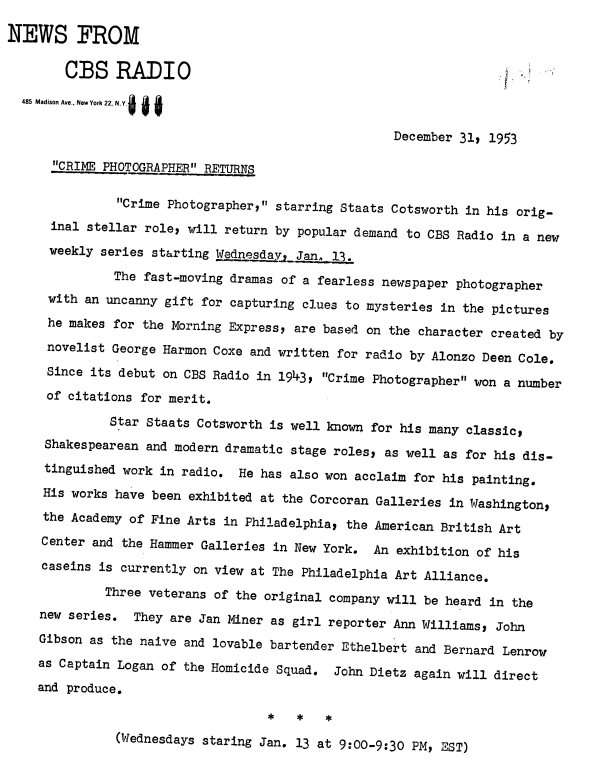
1954-01-14 CBS Press Release
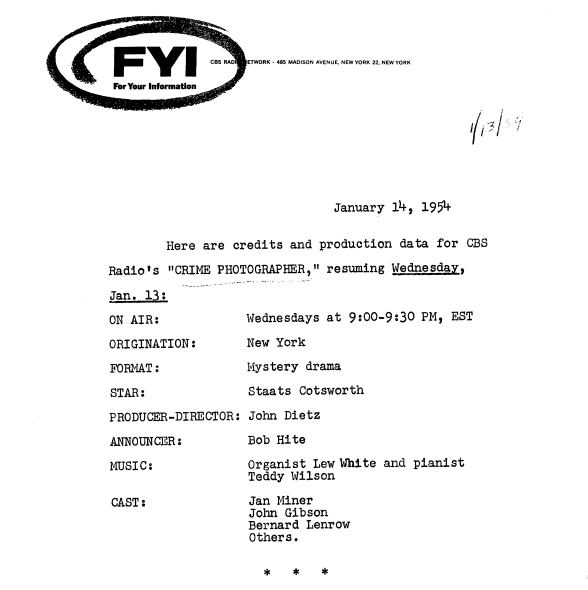
1954-01-15 CBS Press Release
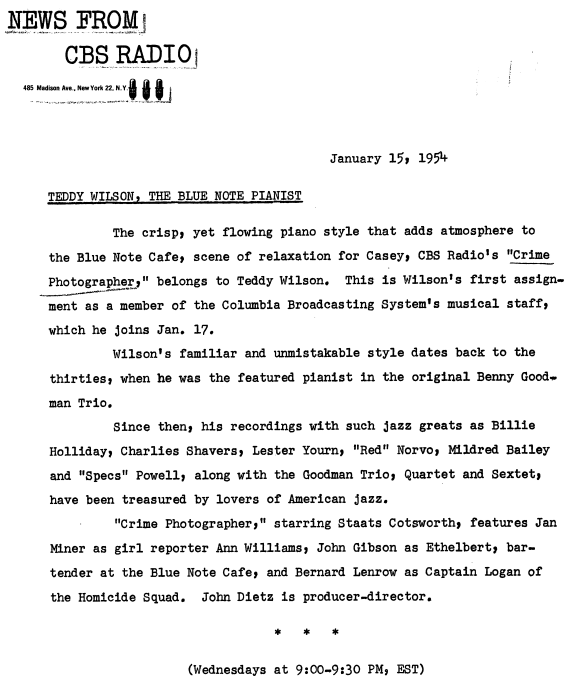
1954-01-07 Kokomo IN Tribune

1954-01-10 Shreveport LA Times

1954-01-13 Charlotte NC Observer


1954-01-14 CBS Press Release

1954-01-15 CBS Press Release

1954-01-07 Kokomo IN Tribune

1954-01-10 Shreveport LA Times

1954-01-13 Charlotte NC Observer

Not everyone was thrilled with the idea. Casey was generally disliked by the critics for most of its run. These are negative comments by columnist Bob Fischer that likely reflect those of others in the newspaper trade. He believed the series lacked realism and trivialized the professional status of newspaper staffers. This did not sit well with Fischer and others. No one ever thought that Casey could be just plain fun and that they might want to go along for the ride.
The episodes recalled its earliest format, using the show opening that was most like Casey, Press Photographer, with Casey clicking his camera and saying "Got it! Look for it in the Morning Express!" Organ music replaced much of the orchestral arrangement, also giving it an early 1940s (and low budget but somewhat innocent) feel.
There were 62 broadcasts. Only the first two survive as circulating recordings, Road Angel and Source of Information. Cole wrote most all of the episodes, and based on what we now know about the original series, the bulk of the 62 are repeated scripts with mild adaptations to them. There are even some broadcasts in the 62 that are repeats of themselves. There are many episodes that are unidentified, and newspapers had so de-emphasized radio coverage and limited it to timetables that plot descriptions are not available. There is a good chance that because the programs were recorded on tape that the tapes were eventually re-used and that the revival broadcasts are gone for good.
1950-11-09 Woman of Mystery
Woman of Mystery is a repeat of Mysterious Lodger, one of the worst episodes of the series. Details are at https://bluenotebulletin.blogspot.com/2020/01/1947-03-06-mysterious-lodger.html
ADC continuity notes...
Eva Condon's part has changed from Mrs. Myers in Mysterious Lodger to Mrs Banks. Details about her interesting career are in the Mysterious Lodger posting.This time the corpus delecti is an attractive young woman who has been stabbed in the back by an obviously powerful man, The police find out that she has been a convicted murderess herself, that she had stabbed her lover and spent several years in prison for her crime. Her landlady says that the brother of the man she murdered has been seen hanging around her lately - and when the cops go to bring him in, he shoots it out with them - and he's killed in the process. It Looks like an open and shut case .. the brother obviously was the killer... But then Casey arrives on the scene. He corroborates the story that the police have learned from the young woman's landlady. And, for some reason, he doesn't believe it's quite as much of an open and shut case as the police believe. Casey develops a theory that the police hadn't even thought of - he unreels some of the peculiar quirks in human nature which ultimately portray the real murderer - the landlady..
Casey 50-11-09 366 Woman of Mystery AFRS#61 (ends Came to you Through -- same script as #175)
FROM DISC.mp3Degoo https://app.degoo.com/share/bWKlLoskvAT2QI
hubiC http://ovh.to/73geSDk
1950-11-02 The Deadly Wolf
The Deadly Wolf is a repeated program of Lady Killer. The details of that episode are at https://bluenotebulletin.blogspot.com/2020/01/1947-07-10-lady-killer.html
ADC continuity notes...
An AFRS disc of this episode (AFRS #60) was recently sold on eBay, and it is hoped that a recording of it is available sometime in the future.
When handsome Oswald Vinton strikes up a conversation with Clarissa Mellish, a rich and bored divorcee, she is definitely intrigued. So Oswald buys her a coupl of drinks, takes her driving and strangles her to death. Casey and Ann are sent to cover the case. They discover that from the description given by the hotel people, Vinton is known by other names to the police as a klller with a long record of murdering rich women, then looting their apartments. The scene shifts to another resort where Jane Kitchener is Vinton (under an assumed name) next intended victim. The hotel manager recognizes him and calls the police. However, by the time they arrive, Vinton has disappeared. With Jane's help Casey sets the trap, which, after an exciting sequence of events, springs the mystery of "The Deadly Wolf."The character names were changed. Lady Killer's Madeleine became Clarissa Mellish; Cecil Gramatan became Oswald Vinton; Clara Simmons was changed to Jane Kitchener.
An AFRS disc of this episode (AFRS #60) was recently sold on eBay, and it is hoped that a recording of it is available sometime in the future.
1950-06-15 Unlucky Numbers
Unlucky Numbers is a better
than average episode, written by Gail & Harry Ingram. The Ingrams
were highly capable writers, and their work indicates great familiarity
with the details of the Casey program and its often lighthearted moments. Harry wrote Scene of the Crime, one of the more entertaining episodes for its focus on Ethelbert as a wannabe detective. The Ingrams seem well-versed in Casey background and continuity, and may be more entertaining than some of Cole's work.
Their collaboration for this episode is an interesting one. The core of the program is Gail's script for The Big Story of 1948-07-21 about "lottery rackets" in Atlanta as uncovered by reporter Keeler McCartney. Harry adapted the script to the characters of Casey resulting in this episode. Both Gail and Harry each contributed scripts to The Big Story radio series, and Gail also composed scripts for The Big Story television series. It is fascinating to have Gail's original script in front of you as you listen to this Casey episode. The script is at https://app.box.com/s/ogqz6zddmr2v0y88i54n15jjm538y301 and is available to the public because scripts of radio programs that were sponsored by cigarette companies became part of the tobacco litigation of the last decades of the 20th century and were made available online for attorneys and the public. (many thanks to Cobalt Club member mjnunes84 for the research tip; The Big Story episode can be heard at YouTube.)
ADC continuity notes... (typos included)
0:42 Ethelbert believes that Gladys wants to marry him, because she said so. He says if he doesn't ask her, she'll be mad. And if he does ask her, she'll say yes. He believes neither result is satisfactory. Casey says he needs to be firm, and not let a woman gain the upper hand... and as he rants, Ethelbert tries to get his attention that Ann has walked in and has been hearing all this.
Ann tells Casey that Burke has an assignment about the numbers racket. Casey sees no problem with the numbers games, so thinks it's a "silly" assignment. Elsewhere in the US, these games may have been referred to as lottery games. Both usually were done in bars as the owners looked the other way or may have gotten an under-the-table cut of the take. If there were problems, they would say they were not aware that such things were happening in their establishment.
2:06 Ethelbert says if they want to know about the numbers, they should ask Steve Polachek, a young patron of the Blue Note, since he plays the games. Ethelbert gives his address as 22 Ward Street.
2:50 Casey and Ann meet Steve's mother. She gets very upset when Casey mentions that they are there to talk about the numbers games, thinking that they are there to collect a gambling debt. She explains that gambling is a sickness and he can't stop playing.
7:55 Casey is going undercover to find out who is behind the games. He's going to pretend to be a numbers runner at Al's Pool Hall. Logan warns him that it's dangerous.
Casey meets "Whitey" who really wants to be one of the tough guys but is not smart enough to be one, and leaks confidential information to Casey constantly. Casey's using the name "Duke." Whitey says the mob is concerned about the stories about numbers that are being written in the Morning Express, and that Casey and Williams may have to be dealt with.
11:43 Inadvertently, one of the local cops recognizes Casey and tries to start a friendly conversation with him in front of Whitey. Casey's cover is blown... but he gets away by pretending he has a gun in his suit jacket pocket.
13:50 Matheson, the gang leader, arranges to ambush Casey at the house with the "silver door" where they killed a cop who was investigating the racket two years ago.
14:45 Whitey approaches Steve in the street to play the game again. Whitey is behind in his receipts and he knows Steve is an easy target, and he gives in for "the last time." Steve is told that the "guys at the silver door" are going to take care of Casey.
16:35 Casey gets a call that is a ruse to get him to the trap. 18:00 Mrs. Polachek meets them to tell them that Steve told her it was a trap and they shouldn't go. 19:00 They realize they are at the house with the silver door, but they can't start the car to go away -- some wires were pulled.
They force Casey to drive to the place where they will kill him. But Casey starts to drive recklessly 21:00 at high speed to put everyone in the car in danger. He runs a red light and a police siren can be heard in the distance. The car crashes in a loud collection of skid and inadequate collision sound effects. The next scene is at the Blue Note.
21:44 Ethelbert asks Casey if he wants another pillow behind his back, which he refuses, though it is clear he is in pain (What's a bar doing with pillows?). The he says "Miss Williams, another pillow under your..." is a fill-in-the-blank much of the audience must have chuckled about.
Matheson was arrested for a long list of crimes, including the Sullivan Act. The law restricted the use of guns in New York, another indication of the locale of the series. https://en.wikipedia.org/wiki/Sullivan_Act Some people at the time imprecisely used the phrase as a generic name for gun laws in general.
Casey admits to driving through eight red lights in the adventurous driving incident; he still may be charged with reckless driving.
22:30 Steve and Mrs. Polachek visit the Blue Note to thank Casey and Ann for their work and that Steve is no longer playing the numbers. They can now save their money for the farm they wanted and more.
The AFRS closing, after some music, is "Tonight's adventure was written by Alonzo Deen Cole. Staat [sic] Cotsworth played the part of Casey, Jan Miner was Ann, and John Gibson was Ethelbert. Next week, another adventure of Casey, Crime Photographer! This is the United States Armed Forces Radio Service, the voice of information and education."
The Polacheks live at 22 Ward Street. There is a home at 22 Ward Street in Norwalk, Connecticut, the town where the Ingrams lived. There is no indication any connection to the Ingrams that I can find at this time. Many writers of the time inserted real addresses to entertain themselves and others they knew. One of the best at it was Jack Johnstone, who used his home address and those of acquaintances in his writing of Johnny Dollar.
Casey 50-06-15 345 Unlucky Numbers AFRS#47.mp3
Degoo https://app.degoo.com/share/LtqUrX5ZnDIteO
hubiC http://ovh.to/q6YviNs
There are no relevant newspaper clippings for this episode.
This chart shows some of the changes Harry made to the script:
The ending is much different and is newly written. The epilogue at the Blue Note has some similarities to the Big Story script.
Gail and Harry Ingram were successful writers and directors of many programs such as Tales of Fatima, The Big Story, The Shadow, Inner Sanctum, and submitted scripts for other series such as Casey, Crime Photographer.
This is the only episode that they wrote jointly. The others were all credited to Harry alone.
48-07-15 246 Farewell Performance
48-08-05 249 Pattern for Murder (2nd use of the title, Cole wrote a different episode with this title)
48-09-16 255 Two Thousand Suspects
48-12-16 267 Blackout
49-03-10 279 The Scene of the Crime
49-06-09 292 Deadline -- Midnight
50-01-12 323 The Love Story
50-04-27 338 Dead Pigeon (2nd use of the title, Cole wrote a different episode with this title)
50-06-15 345 Unlucky Numbers
Pictures of Gail and Harry Ingram can be found at Getty Images
https://www.gettyimages.com/photos/gail-harry-ingram?mediatype=photography&phrase=gail%20harry%20ingram&sort=mostpopular
Harry's death was very unexpected.
Gail Ingram continued her career long after Harry's death. This blogpost has some excellent background about her.
https://classictvhistory.wordpress.com/2007/12/21/in-memoriam-gail-ingram-1924-2007/
Harry's script, Blackout, became a photostory in the Summer 1949 edition of Radio Album. The name was changed to Finger of Suspicion. Here is the first page...
Strangely, they give Casey the first name of "Steve" in the article! His name was "Jack" in the pulps. Based on the recordings we have, his first name was never used, but it did appear in some newspaper clippings. Perhaps the writer or editor of the piece was thinking of "Steve Wilson," lead character of the Big Town series?
These photoplays can be great fun to view. Even the gangsters are in suits and ties! These give you a chance to see the stars of the programs. The pictures are so staged and stilted, for the most part, that they have an innocence to them and give the reader a chuckle. Cotsworth can really ham it up for some of the photos, and those are great, too.
Download the full photoplay article as a PDF
https://my.pcloud.com/publink/show?code=XZ6GoMkZvP1cuz3WBKSa0muAGQ7pi5p8bBWX
The series celebrated its eighth anniversary in July 1950. Below is the anniversary press release from CBS. The series would end four months later, when Philip Morris let its contract expire.
Their collaboration for this episode is an interesting one. The core of the program is Gail's script for The Big Story of 1948-07-21 about "lottery rackets" in Atlanta as uncovered by reporter Keeler McCartney. Harry adapted the script to the characters of Casey resulting in this episode. Both Gail and Harry each contributed scripts to The Big Story radio series, and Gail also composed scripts for The Big Story television series. It is fascinating to have Gail's original script in front of you as you listen to this Casey episode. The script is at https://app.box.com/s/ogqz6zddmr2v0y88i54n15jjm538y301 and is available to the public because scripts of radio programs that were sponsored by cigarette companies became part of the tobacco litigation of the last decades of the 20th century and were made available online for attorneys and the public. (many thanks to Cobalt Club member mjnunes84 for the research tip; The Big Story episode can be heard at YouTube.)
ADC continuity notes... (typos included)
Casey and Ann are set out to get some info. on "the numbers racket". They interview the mother or one or the youngsters who has fallen victim to the lure or the numbers game. Mrs. Polachek tells how her son Steve cannot resist trying his luck each week, using his hard-earned money and even going so far as to use the family savings when his own gives out... She is bitter about the whole things and begs Casey to put a stop to it. Casey does some sleuthing and meets up with the head of the numbers racket and with the help or Mrs. Polachek and her son, puts an end to this worthless racket.
0:42 Ethelbert believes that Gladys wants to marry him, because she said so. He says if he doesn't ask her, she'll be mad. And if he does ask her, she'll say yes. He believes neither result is satisfactory. Casey says he needs to be firm, and not let a woman gain the upper hand... and as he rants, Ethelbert tries to get his attention that Ann has walked in and has been hearing all this.
Ann tells Casey that Burke has an assignment about the numbers racket. Casey sees no problem with the numbers games, so thinks it's a "silly" assignment. Elsewhere in the US, these games may have been referred to as lottery games. Both usually were done in bars as the owners looked the other way or may have gotten an under-the-table cut of the take. If there were problems, they would say they were not aware that such things were happening in their establishment.
2:06 Ethelbert says if they want to know about the numbers, they should ask Steve Polachek, a young patron of the Blue Note, since he plays the games. Ethelbert gives his address as 22 Ward Street.
2:50 Casey and Ann meet Steve's mother. She gets very upset when Casey mentions that they are there to talk about the numbers games, thinking that they are there to collect a gambling debt. She explains that gambling is a sickness and he can't stop playing.
7:55 Casey is going undercover to find out who is behind the games. He's going to pretend to be a numbers runner at Al's Pool Hall. Logan warns him that it's dangerous.
Casey meets "Whitey" who really wants to be one of the tough guys but is not smart enough to be one, and leaks confidential information to Casey constantly. Casey's using the name "Duke." Whitey says the mob is concerned about the stories about numbers that are being written in the Morning Express, and that Casey and Williams may have to be dealt with.
11:43 Inadvertently, one of the local cops recognizes Casey and tries to start a friendly conversation with him in front of Whitey. Casey's cover is blown... but he gets away by pretending he has a gun in his suit jacket pocket.
13:50 Matheson, the gang leader, arranges to ambush Casey at the house with the "silver door" where they killed a cop who was investigating the racket two years ago.
14:45 Whitey approaches Steve in the street to play the game again. Whitey is behind in his receipts and he knows Steve is an easy target, and he gives in for "the last time." Steve is told that the "guys at the silver door" are going to take care of Casey.
16:35 Casey gets a call that is a ruse to get him to the trap. 18:00 Mrs. Polachek meets them to tell them that Steve told her it was a trap and they shouldn't go. 19:00 They realize they are at the house with the silver door, but they can't start the car to go away -- some wires were pulled.
They force Casey to drive to the place where they will kill him. But Casey starts to drive recklessly 21:00 at high speed to put everyone in the car in danger. He runs a red light and a police siren can be heard in the distance. The car crashes in a loud collection of skid and inadequate collision sound effects. The next scene is at the Blue Note.
21:44 Ethelbert asks Casey if he wants another pillow behind his back, which he refuses, though it is clear he is in pain (What's a bar doing with pillows?). The he says "Miss Williams, another pillow under your..." is a fill-in-the-blank much of the audience must have chuckled about.
Matheson was arrested for a long list of crimes, including the Sullivan Act. The law restricted the use of guns in New York, another indication of the locale of the series. https://en.wikipedia.org/wiki/Sullivan_Act Some people at the time imprecisely used the phrase as a generic name for gun laws in general.
Casey admits to driving through eight red lights in the adventurous driving incident; he still may be charged with reckless driving.
22:30 Steve and Mrs. Polachek visit the Blue Note to thank Casey and Ann for their work and that Steve is no longer playing the numbers. They can now save their money for the farm they wanted and more.
The AFRS closing, after some music, is "Tonight's adventure was written by Alonzo Deen Cole. Staat [sic] Cotsworth played the part of Casey, Jan Miner was Ann, and John Gibson was Ethelbert. Next week, another adventure of Casey, Crime Photographer! This is the United States Armed Forces Radio Service, the voice of information and education."
The Polacheks live at 22 Ward Street. There is a home at 22 Ward Street in Norwalk, Connecticut, the town where the Ingrams lived. There is no indication any connection to the Ingrams that I can find at this time. Many writers of the time inserted real addresses to entertain themselves and others they knew. One of the best at it was Jack Johnstone, who used his home address and those of acquaintances in his writing of Johnny Dollar.
Casey 50-06-15 345 Unlucky Numbers AFRS#47.mp3
Degoo https://app.degoo.com/share/LtqUrX5ZnDIteO
hubiC http://ovh.to/q6YviNs
There are no relevant newspaper clippings for this episode.
This chart shows some of the changes Harry made to the script:
The ending is much different and is newly written. The epilogue at the Blue Note has some similarities to the Big Story script.
* * * * * * * * * * * * * * * * * * * * * * * * * * * * * *
Gail and Harry Ingram were successful writers and directors of many programs such as Tales of Fatima, The Big Story, The Shadow, Inner Sanctum, and submitted scripts for other series such as Casey, Crime Photographer.
This is the only episode that they wrote jointly. The others were all credited to Harry alone.
48-07-15 246 Farewell Performance
48-08-05 249 Pattern for Murder (2nd use of the title, Cole wrote a different episode with this title)
48-09-16 255 Two Thousand Suspects
48-12-16 267 Blackout
49-03-10 279 The Scene of the Crime
49-06-09 292 Deadline -- Midnight
50-01-12 323 The Love Story
50-04-27 338 Dead Pigeon (2nd use of the title, Cole wrote a different episode with this title)
50-06-15 345 Unlucky Numbers
Pictures of Gail and Harry Ingram can be found at Getty Images
https://www.gettyimages.com/photos/gail-harry-ingram?mediatype=photography&phrase=gail%20harry%20ingram&sort=mostpopular
Harry's death was very unexpected.
Gail Ingram continued her career long after Harry's death. This blogpost has some excellent background about her.
https://classictvhistory.wordpress.com/2007/12/21/in-memoriam-gail-ingram-1924-2007/
* * * * * * * * * * * * * * * * * * * * * * * * * * * * * *
Harry's script, Blackout, became a photostory in the Summer 1949 edition of Radio Album. The name was changed to Finger of Suspicion. Here is the first page...
Strangely, they give Casey the first name of "Steve" in the article! His name was "Jack" in the pulps. Based on the recordings we have, his first name was never used, but it did appear in some newspaper clippings. Perhaps the writer or editor of the piece was thinking of "Steve Wilson," lead character of the Big Town series?
These photoplays can be great fun to view. Even the gangsters are in suits and ties! These give you a chance to see the stars of the programs. The pictures are so staged and stilted, for the most part, that they have an innocence to them and give the reader a chuckle. Cotsworth can really ham it up for some of the photos, and those are great, too.
Download the full photoplay article as a PDF
https://my.pcloud.com/publink/show?code=XZ6GoMkZvP1cuz3WBKSa0muAGQ7pi5p8bBWX
* * * * * * * * * * * * * * * * * * * * * * * * * * * * * *
The series celebrated its eighth anniversary in July 1950. Below is the anniversary press release from CBS. The series would end four months later, when Philip Morris let its contract expire.
1950-05-04 The Suicide
The Suicide is a repeated script that was originally presented on 1945-02-15 with the title Suicide Note. The last time a Broadway-like venue was used was for 1947-07-31 Bright New Star and a non-Cole script 1947-11-13 Too Many Angels
were in similar settings of failed plays. This time, a handwritten page
of draft dialogue from a very bad play was cut to look like a suicide
note. Cole pulls the ol' life-insurance-doesn't-pay-for-suicides routine
out of his back pocket. This is an average episode with a predictable
plot, but generally well-executed.
ADC continuity notes (notes for 1945-02-15 Suicide Note are the same)...
Every time I think of a failed Broadway play, I think of Mel Brooks' The Producers.
- Carl Ashby was the author of the play, a businessman who decided to try his hand at writing.
- Lee Gorman is the producer of the play, who decides to close the play after one night; according to Ann Williams, he is a "beautiful hunk of man."
- Nedra Millard is the star of the play... "Nedra" backwards is "Arden." Could Cole have had Eve Arden in mind? Nedra is Ashby's wife. Cole could have been stuck for a name. The actress-singer Nedra Volz was not active in this era https://en.wikipedia.org/wiki/Nedra_Volz but Cole may have heard of her from her big band singing career in the Midwest. She was not well-known.
- Ben Cartwright is Ashby's lawyer (no, not Ben from the TV show of years later).
4:10 Ethelbert says to them "Say, I didn't see you two last night. Where was you?" He says that Ashby is a regular at the Blue Note.
5:40 Casey is told that Ashby has committed suicide. 6:00 Logan says it's an open and shut case. 7:25 Nedra seems to have a perfect alibi.
7:50 Casey sees the suicide note, and the top of the page has been torn off, and the note is not signed. 8:40 He's really suspicious about it.
10:40 Nedra uses almost the same words "all of us make mistakes, don't we... big ones..." as Gorman did at 1:53 "one of those big mistakes we make at one time or another." The "mistakes" line is used at the end about a sports bet Casey makes.
11:15 Casey explains it all to Logan: Nedra married Carl for his money, but she continued to be interested in Lee. They figured a way to get rid of Carl. Carl wanted to write a play, and Nedra and Lee helped him in such a way to ensure it was a flop. The play dealt with a suicide, so they concocted a way for him to draft in longhand some dialogue that would fit neatly near the center of a page that could be contrived to be a suicide note once they trim the paper to remove the various aspects of character identification and stage direction. The ridicule about the play would give reason to the suicide. 13:21 Casey explains that Lee had a key to the apartment and pushed Carl out the window, and then returned to the post-show event by way of the freight elevator.
14:00 Logan explains that the insurance policy Carl had was less than a year old, and would be void if death was by suicide. Logan says that Carl's lawyer says he was not as wealthy as believed. Casey believes that the voided insurance policy was actually part of the plan so no one would suspect Nedra of the murder because there was no financial incentive for it. Casey and the lawyer, Ben Cartwright, meet. The lawyer agrees, at Casey's urging, to tell Nedra that Carl was only worth $10,000 ($110,000 in 2020 dollars) and not $500,000 ($5.5 million in 2020 dollars).
18:48 Nedra meets Lee... neither of them knew about the insurance policy being voided. Now, she will turn on Lee and make it clear that Lee murdered him. 20:40 There's a gun in the room and Nedra has it as she says to Lee: "This gun will tell you what I mean" as she threatens to kill him unless he writes a confession that he was behind everything. Before she has a chance to shoot him, 21:27 Logan shoots the gun from her hand. Casey and Logan had rigged a Dictaphone to record everything they said about the murder. An ad for a 1950 Dictaphone product is at http://file.vintageadbrowser.com/n0kb0wqt4x8wgm.jpg The inventor of the core technology for the first Dictaphones was Alexander Graham Bell.
At the close of the episode, Casey mentions he bet Logan that the Red Sox would win today. They lost, Casey reports. And in real life, they lost, too, 5-4 with Cleveland's Bob Lemon beating the BoSox Mel Parnell. It was a day game, and it was over at about 4:30, they had time to adjust the script in any manner needed to make whatever Casey said be true. https://www.baseball-reference.com/boxes/BOS/BOS195005040.shtml This line was newly added to this script because the original performance of this script was in February of 1945, two months before the baseball season would begin. This adds again to the question as to the locale of Casey, Boston or New York. If it was Boston, Casey would be unhappy if they lost. In New York, the saying has always been "I root for only two baseball teams, the Yankees and whoever is playing the Red Sox."
The AFRS closing is music after the Blue Note epilogue and then "This adventure of Crime Photographer starring Staat [sic] Cotsworth as Casey, came to you through the worldwide facilities of the United States Armed Forces Radio Service, the voice of information and education."
Casey 50-05-04 339 The Suicide AFRS UPGRADE.mp3
Degoo https://app.degoo.com/share/kTA9PhPtwoabtN
hubiC http://ovh.to/ThtNpit
There were no newspaper clippings related to this episode.
This news item was available, however. The 2020 value of Cole's payments were $275,000. It did not last much longer. Cole was not able to adjust to television writing, and did not have any other outlets for his work. More details in an upcoming post, some of it tragic.
ADC continuity notes (notes for 1945-02-15 Suicide Note are the same)...
After his play in which his wife starred and which was produced by her boyfriend fails an author is supposedly a suicide, having jumped from his hotel window while his wife was in the lobby talking with some people. He left a corny suicide note which Casey thinks was from a cut scene of his play. Casey gets the dead man's lawyer to tell the widow that he left very little money and that she forfeits the insurance because death was by suicide, As he thought she would, she goes to see the boyfriend and forces him to write a confession of murder after which she plans to kill him and make that too look like suicide; the police break in before she can complete her plans.
Every time I think of a failed Broadway play, I think of Mel Brooks' The Producers.
- Carl Ashby was the author of the play, a businessman who decided to try his hand at writing.
- Lee Gorman is the producer of the play, who decides to close the play after one night; according to Ann Williams, he is a "beautiful hunk of man."
- Nedra Millard is the star of the play... "Nedra" backwards is "Arden." Could Cole have had Eve Arden in mind? Nedra is Ashby's wife. Cole could have been stuck for a name. The actress-singer Nedra Volz was not active in this era https://en.wikipedia.org/wiki/Nedra_Volz but Cole may have heard of her from her big band singing career in the Midwest. She was not well-known.
- Ben Cartwright is Ashby's lawyer (no, not Ben from the TV show of years later).
4:10 Ethelbert says to them "Say, I didn't see you two last night. Where was you?" He says that Ashby is a regular at the Blue Note.
5:40 Casey is told that Ashby has committed suicide. 6:00 Logan says it's an open and shut case. 7:25 Nedra seems to have a perfect alibi.
7:50 Casey sees the suicide note, and the top of the page has been torn off, and the note is not signed. 8:40 He's really suspicious about it.
10:40 Nedra uses almost the same words "all of us make mistakes, don't we... big ones..." as Gorman did at 1:53 "one of those big mistakes we make at one time or another." The "mistakes" line is used at the end about a sports bet Casey makes.
11:15 Casey explains it all to Logan: Nedra married Carl for his money, but she continued to be interested in Lee. They figured a way to get rid of Carl. Carl wanted to write a play, and Nedra and Lee helped him in such a way to ensure it was a flop. The play dealt with a suicide, so they concocted a way for him to draft in longhand some dialogue that would fit neatly near the center of a page that could be contrived to be a suicide note once they trim the paper to remove the various aspects of character identification and stage direction. The ridicule about the play would give reason to the suicide. 13:21 Casey explains that Lee had a key to the apartment and pushed Carl out the window, and then returned to the post-show event by way of the freight elevator.
14:00 Logan explains that the insurance policy Carl had was less than a year old, and would be void if death was by suicide. Logan says that Carl's lawyer says he was not as wealthy as believed. Casey believes that the voided insurance policy was actually part of the plan so no one would suspect Nedra of the murder because there was no financial incentive for it. Casey and the lawyer, Ben Cartwright, meet. The lawyer agrees, at Casey's urging, to tell Nedra that Carl was only worth $10,000 ($110,000 in 2020 dollars) and not $500,000 ($5.5 million in 2020 dollars).
18:48 Nedra meets Lee... neither of them knew about the insurance policy being voided. Now, she will turn on Lee and make it clear that Lee murdered him. 20:40 There's a gun in the room and Nedra has it as she says to Lee: "This gun will tell you what I mean" as she threatens to kill him unless he writes a confession that he was behind everything. Before she has a chance to shoot him, 21:27 Logan shoots the gun from her hand. Casey and Logan had rigged a Dictaphone to record everything they said about the murder. An ad for a 1950 Dictaphone product is at http://file.vintageadbrowser.com/n0kb0wqt4x8wgm.jpg The inventor of the core technology for the first Dictaphones was Alexander Graham Bell.
At the close of the episode, Casey mentions he bet Logan that the Red Sox would win today. They lost, Casey reports. And in real life, they lost, too, 5-4 with Cleveland's Bob Lemon beating the BoSox Mel Parnell. It was a day game, and it was over at about 4:30, they had time to adjust the script in any manner needed to make whatever Casey said be true. https://www.baseball-reference.com/boxes/BOS/BOS195005040.shtml This line was newly added to this script because the original performance of this script was in February of 1945, two months before the baseball season would begin. This adds again to the question as to the locale of Casey, Boston or New York. If it was Boston, Casey would be unhappy if they lost. In New York, the saying has always been "I root for only two baseball teams, the Yankees and whoever is playing the Red Sox."
The AFRS closing is music after the Blue Note epilogue and then "This adventure of Crime Photographer starring Staat [sic] Cotsworth as Casey, came to you through the worldwide facilities of the United States Armed Forces Radio Service, the voice of information and education."
Casey 50-05-04 339 The Suicide AFRS UPGRADE.mp3
Degoo https://app.degoo.com/share/kTA9PhPtwoabtN
hubiC http://ovh.to/ThtNpit
There were no newspaper clippings related to this episode.
This news item was available, however. The 2020 value of Cole's payments were $275,000. It did not last much longer. Cole was not able to adjust to television writing, and did not have any other outlets for his work. More details in an upcoming post, some of it tragic.
1950-04-13 The Disappearance of Mr Dizzel
Disappearance of Mr. Dizzel was a re-use of the script from 1945-06-12 The Strange Case of Mr. Strange.
It's an interesting script for a while but the details of the
disappearance end up being simplistic and defy the mildest application
of practical scrutiny.
For many years this episode circulated in bad sound, and no one was able to figure out the title or the spelling. In the 1970s, it would be listed as "The Disappearance of Adam Gazelle" or other approximations.
ADC continuity notes (the same for both broadcasts)...
00:50 There are some what may be considered caricatured portrayals of black servants (Louella and Henry Clarence) who work for Mr. Dizzel, speaking with exaggerated accents. It sounds like actors of that background (I suspect portraying the parts as they were "supposed" to sound) and are not imitations by other actors. They are not identified in the credits, but we know Casey only identified central characters and not supporting ones. Since we don't have the network copies of either broadcast or the scripts, we may never know. Cotsworth was very active quietly behind-the-scenes in getting helping actors get into roles on Broadway and radio and situations that broke some barriers. Perhaps that is the case here; again, we're 70 years removed from the day of broadcast so we can't be sure.
It's assumed from the beginning that Dizzel was kidnapped and there will be a call for ransom.
Professor Ishka is rare book thief who wants to do well and make amends after his release from prison. He goes to Casey because he knows the authorities won't believe him and doesn't want to be considered a snitch.
Bruce Madden, Jr. is a well-known extortionist. Neil Lawrence is Dizzel's nephew. Logan thinks they're in cahoots. Madden, Sr. cut his son off for his playboy and spendthrift ways. The Maddens are only referenced; they have no lines.
Another book dealer, Paul Vladimir, is killed later, at the same time as the Dizzel incident occurs, and the same kind of gun was used. We learn he was Ishka's brother.
8:00 Ann is suspicious of a kidnap plot from the beginning.
9:05 The ransom letter appears, placed under Lawrence's door. It's Dizzel's handwriting and says the kidnappers want $150,000. That's more than $1.6 million in 2020 dollars.
11:15 The indication is made by Louella that the building has been renovated with an impractical layout in the conversion from home to book shop. Moving from room-to-room is not intuitively navigated. This plays into the solution. 12:35 It's noted that there are phone extensions all over the house. In 1950, this was considered to be a sign of affluence because of the high costs. More than 35% of homes did not have phones in 1950.
14:15 Ann is still skeptical of Lawrence as the kidnapper.
14:46 Mr. Evans, a new customer at the Blue Note, diverts Ethelbert's attention; not sure which actor is doubling here. While Ethelbert steps away, Professor Ishka gets Casey's ear for a while and gives him some insights into Dizzel's dealings, which were not always ethical. He says that Vladimir was his brother and Dizzel killed him. Dizzel was a fence for stolen books, and that Dizzel was not kidnapped and is still alive, hiding.
18:45 Another envelope has been found. 19:05 It's a letter of instruction from Dizzel to his nephew. Casey gets suspicious. The note was tied to a piece of fire brick, not a rock. For some reason, this is a clue to Casey. He asks for some tear gas canisters.
20:58 The tear gas is dropped into a chimney -- and Dizzel comes out, gasping for air, from behind a bookcase with a gun! He drops the gun and surrenders.
21:35 The tear gas spills into the area, affecting Casey. He says he hasn't "cried so much since the Dodgers... well, you know..." He's could be referring to the 1949 World Series where the Dodgers lost to the Yankees in five games https://www.baseball-reference.com/postseason/1949_WS.shtml but more likely the 1947 series where the Dodgers lost in seven games https://www.baseball-reference.com/postseason/1947_WS.shtml Since this is a re-used script, this line may have been added. If the 1945 script had a World Series reference that was left intact, it would refer to the 1941 series https://www.baseball-reference.com/postseason/1941_WS.shtml This is another reference that implies Casey is based in New York.
Back at the Blue Note, Casey explains that Dizzel had a hiding place in the house where he could store stolen books and was using the room hide until he could escape with his own ransom money. It's unlikely his staying in the room could be pulled off in practical daily life. There's no mention of a lavatory in the hiding place, and servants and his nephew would have heard him using such for personal hygiene, or his having to leave the room for that. Dizzel was raiding the kitchen when everyone else in the house was asleep, and eventually he would have been detected, even accidentally by spilling something or dropping something. He would have been found out, just by moving around in an older home with its usual creakiness of floorboards and doors.
23:40 Ann is having a date with Mr. Lawrence, whom she always knew was innocent. Casey is mildly jealous.
The AFRS closing is "This is the United States Armed Forces Radio Service, the voice of information and education."
Casey 50-04-13 336 The Disappearance of Mr Dizzel AFRS.mp3
Degoo https://app.degoo.com/share/14UY26YoOGtp5V
hubiC http://ovh.to/NcbSgoq
There are no newspaper clippings associated with this particular presentation.
This was not the episode originally promoted for this date. The substitution was made after the press releases were sent. The announced performance was done on another date, likely with a slightly different title.
For many years this episode circulated in bad sound, and no one was able to figure out the title or the spelling. In the 1970s, it would be listed as "The Disappearance of Adam Gazelle" or other approximations.
ADC continuity notes (the same for both broadcasts)...
The servants of a wealthy dealer in rare books return from their night off to see two men helping a third out or the house and inside they find bullet holes and bloodstains, but no body. Police believe that someone broke in and kidnapped the old man, and his nephew who has been friendly with several questionable characters is suspected. Ransom notes arrive at the nephew's door. The old man has been hiding in the fireplace chimney of his own den and has slipped the notes under the door himself at night in order to secure money to leave the country because his crooked dealings in book have been discovered by the other dealers.
00:50 There are some what may be considered caricatured portrayals of black servants (Louella and Henry Clarence) who work for Mr. Dizzel, speaking with exaggerated accents. It sounds like actors of that background (I suspect portraying the parts as they were "supposed" to sound) and are not imitations by other actors. They are not identified in the credits, but we know Casey only identified central characters and not supporting ones. Since we don't have the network copies of either broadcast or the scripts, we may never know. Cotsworth was very active quietly behind-the-scenes in getting helping actors get into roles on Broadway and radio and situations that broke some barriers. Perhaps that is the case here; again, we're 70 years removed from the day of broadcast so we can't be sure.
It's assumed from the beginning that Dizzel was kidnapped and there will be a call for ransom.
Professor Ishka is rare book thief who wants to do well and make amends after his release from prison. He goes to Casey because he knows the authorities won't believe him and doesn't want to be considered a snitch.
Bruce Madden, Jr. is a well-known extortionist. Neil Lawrence is Dizzel's nephew. Logan thinks they're in cahoots. Madden, Sr. cut his son off for his playboy and spendthrift ways. The Maddens are only referenced; they have no lines.
Another book dealer, Paul Vladimir, is killed later, at the same time as the Dizzel incident occurs, and the same kind of gun was used. We learn he was Ishka's brother.
8:00 Ann is suspicious of a kidnap plot from the beginning.
9:05 The ransom letter appears, placed under Lawrence's door. It's Dizzel's handwriting and says the kidnappers want $150,000. That's more than $1.6 million in 2020 dollars.
11:15 The indication is made by Louella that the building has been renovated with an impractical layout in the conversion from home to book shop. Moving from room-to-room is not intuitively navigated. This plays into the solution. 12:35 It's noted that there are phone extensions all over the house. In 1950, this was considered to be a sign of affluence because of the high costs. More than 35% of homes did not have phones in 1950.
14:15 Ann is still skeptical of Lawrence as the kidnapper.
14:46 Mr. Evans, a new customer at the Blue Note, diverts Ethelbert's attention; not sure which actor is doubling here. While Ethelbert steps away, Professor Ishka gets Casey's ear for a while and gives him some insights into Dizzel's dealings, which were not always ethical. He says that Vladimir was his brother and Dizzel killed him. Dizzel was a fence for stolen books, and that Dizzel was not kidnapped and is still alive, hiding.
18:45 Another envelope has been found. 19:05 It's a letter of instruction from Dizzel to his nephew. Casey gets suspicious. The note was tied to a piece of fire brick, not a rock. For some reason, this is a clue to Casey. He asks for some tear gas canisters.
20:58 The tear gas is dropped into a chimney -- and Dizzel comes out, gasping for air, from behind a bookcase with a gun! He drops the gun and surrenders.
21:35 The tear gas spills into the area, affecting Casey. He says he hasn't "cried so much since the Dodgers... well, you know..." He's could be referring to the 1949 World Series where the Dodgers lost to the Yankees in five games https://www.baseball-reference.com/postseason/1949_WS.shtml but more likely the 1947 series where the Dodgers lost in seven games https://www.baseball-reference.com/postseason/1947_WS.shtml Since this is a re-used script, this line may have been added. If the 1945 script had a World Series reference that was left intact, it would refer to the 1941 series https://www.baseball-reference.com/postseason/1941_WS.shtml This is another reference that implies Casey is based in New York.
Back at the Blue Note, Casey explains that Dizzel had a hiding place in the house where he could store stolen books and was using the room hide until he could escape with his own ransom money. It's unlikely his staying in the room could be pulled off in practical daily life. There's no mention of a lavatory in the hiding place, and servants and his nephew would have heard him using such for personal hygiene, or his having to leave the room for that. Dizzel was raiding the kitchen when everyone else in the house was asleep, and eventually he would have been detected, even accidentally by spilling something or dropping something. He would have been found out, just by moving around in an older home with its usual creakiness of floorboards and doors.
23:40 Ann is having a date with Mr. Lawrence, whom she always knew was innocent. Casey is mildly jealous.
The AFRS closing is "This is the United States Armed Forces Radio Service, the voice of information and education."
Casey 50-04-13 336 The Disappearance of Mr Dizzel AFRS.mp3
Degoo https://app.degoo.com/share/14UY26YoOGtp5V
hubiC http://ovh.to/NcbSgoq
There are no newspaper clippings associated with this particular presentation.
This was not the episode originally promoted for this date. The substitution was made after the press releases were sent. The announced performance was done on another date, likely with a slightly different title.
1950-04-06 The Fire
The Fire is a typical Casey episode, but has a little more
than usual flirty interplay with Casey and Ann because one of the clues
to the solution is the diamond rings in the story. Casey hates them;
Ann loves them.
As I'm digging through the broadcast history of this series I have been finding many more repeats than expected and originally thought. Cole often changed the names of his scripts when they would be reused. And when he repeated them, he usually changed the names of the characters. In the Thunderbolt episode we heard many similarities with Gentle Strangler. We can't detect them all because we only have 80 recordings. They occur so often in those 80, that it suggests the reuse of concepts, sections of dialogue, and scripts was almost rampant. This particular script was broadcast on 1946-05-07 with the title The Man Nobody Liked. I will be creating a chart of such repeats as I have been able to find them, and will be updating the Casey log as well.
ADC continuity notes...
We learn early on that the apartment was burned after someone was searching through it, and did not find what they wanted to. So they wanted to make sure that if it was there but didn't find it, that the fire would destroy it. The original thought of Casey and Logan was the fire was to cover the murder and anything else that would lead to their detection. Later they realize it was to cover up the murder and destroy additional evidence.
This is another episode where the person had photographic developing in a home. The prior episode was Murder in Black and White.
Keep track of the names: Milton is the bookkeeper, killed as part of the fire cover-up. The cashier, Crowley, is the one who uncovered the embezzlement.
Milton was killed by being struck with a piece of iron... a crowbar later figures into the story.
10:30 Essential clue: "the big white rock that looked like a warty cucumber" is a recognizable rock that fell during the landslide. Casey says it's a wonder that the rock "didn't do a Brodie a long time ago." Steve Brodie claimed to jump off the Brooklyn Bridge in 1866, so any long fall jump went into the popular vocabulary as "do a Brodie." https://en.wikipedia.org/wiki/Steve_Brodie_(bridge_jumper) NY Daily News columnist Jimmy Breslin wrote in his May 24, 1983 column that Brodie put sand in his socks, a lot of it, to be sure he went feet first for the dive of 135 feet and went smoothly into the water with barely a splash. Then he took his socks off underwater and came right up.
10:55 The old timer says someone could move the rock with a crowbar, but the rain seemed to have done it... little does he know...
11:30 Ethelbert knows Casey seems very sad not in the mood for talking. Casey admits Ann is angry at him. Ethelbert says if it's over diamonds, he knows that's a sore subject among women.
13:30 Ann tells Casey the police say it's a case of embezzlement. Casey is now figuring out the logic of the case.
15:00 Casey and Ann are at Milton's burned out apartment looking for clues. Casey finds rolled up film inside a curtain rod. Just as they're about to turn around and leave, they're both attacked and knocked out. When they become conscious, Casey finds a piece of a negative. It has part of the "cucumber rock" and part of a hand holding a crowbar, and the hand has a diamond ring on a finger!
20:05 Casey relates the full story of the case to Logan, Winber, and Haywood, and the cover-up. Crowley had figured out one of the executives was embezzling, and wanted to put the blame onto Crowley the cashier who was leaving on vacation, to make it look like he absconded with the funds. The executive threw Crowley over the edge of the cliff, then caused the landslide. Milton the bookkeeper decided to trail the executive, and took a pictures of him causing the landslide so he could blackmail him. Instead, Milton was killed, and the executive frantically searched for the films and could not find them. It was not until Casey and Ann went back to the apartment and found them hidden in the curtain rod that anyone knew where the film was, and that's when they we struck, and he got away with the film, except for a small incriminating image. Casey was not certain if it was Winber or Haywood, but when he saw that Haywood was not wearing his diamond ring, he knew who the culprit was. When he holds a gun and tries to escape, Ann knocks Haywood out with a swing of her handbag -- she has a brick in it in case she had the chance for revenge for the attack of the other day.
The diamond exchanges:
7:43 Windber wears a diamond ring that he rotated to hide or protect the stone in his hand. Casey and Ann notice.
8:47 Ann says someday she will "quit this newspaper racket, and get married, and live like a human being."
8:57 Casey asks if she picked a guy and she says "I will pick the first one that puts a diamond on my finger." Windber's diamond was big but she says that a small diamond "will do."
9:16 Casey says "personally I got no use for diamonds." Ann responds somewhat sternly "you wouldn't."
9:30 The landscape unfolds in front of them as they drive through the country. Casey says "It's nature in her fairest aspects, budding trees, new grass, birds..." and Ann says "and bees."
11:05 The old-timer says goodbye to Casey "and his Missus" and Ann yells back "I'm not his Missus... I'm not even his friend... I hate men who have no use for diamonds."
23:40 Ann finally gets a diamond ring... Winber gave Ann his diamond ring as a reward for her role in the case.
The AFRS closing is music after the Blue Note epilogue and then "This adventure of Crime Photographer starring Staat [sic] Cotsworth as Casey, came to you through the worldwide facilities of the United States Armed Forces Radio Service, the voice of information and education."
Casey 50-04-06 335 The Fire AFRS.mp3
Degoo https://app.degoo.com/share/GXv9fw7JJO84Rm
hubiC http://ovh.to/kBHxXmt
There are no newspaper clippings related to this episode.
As I'm digging through the broadcast history of this series I have been finding many more repeats than expected and originally thought. Cole often changed the names of his scripts when they would be reused. And when he repeated them, he usually changed the names of the characters. In the Thunderbolt episode we heard many similarities with Gentle Strangler. We can't detect them all because we only have 80 recordings. They occur so often in those 80, that it suggests the reuse of concepts, sections of dialogue, and scripts was almost rampant. This particular script was broadcast on 1946-05-07 with the title The Man Nobody Liked. I will be creating a chart of such repeats as I have been able to find them, and will be updating the Casey log as well.
ADC continuity notes...
50-04-06 TYPOS INCLUDED
A clerk in the bookkeeping department on Mr. Windber's company is found murdered and an unsuccessful attempt is made to destroy his apartment by starting a fire. On checking with the firm, Casey and Logan learn that the cashier under whom the clerk worked had disappeared several weeks ago. Casey believes the two are connected and that that was the reason the clerk was killed. At the interview both Mr. Windber and Mr. Haywood, the V.P., wear diamond rings. ON the drive home Casey and Ann notice that a large rock has fallen off a cliff or been pried loose to create a landslide. At the clerk's apartment they find a small roll of film hidden and as they look at it they are struck from behind and the only bit of film their assailant doesn't get shows a man's hand wearing a diamond ring, and also a bit of the rock that had been pried loose. When they return to the plant, Haywood is no longer wearing his ring, so he is the killer. Haywood is the one who stole the money. He killed the Cashier, threw his body over the cliff and then started the landslide to cover it in order that the embezzlement would be blamed on him. The clerk was killed because he had seen the whole thing and recorded it on film.
1946-05-07 The Man Nobody Liked
A clerk in the bookkeeping department on Mr. Norbitt's company is found murdered and an unsuccessful attempt is made to destroy his apartment by starting a fire. On checking with the firm, Casey and Logan learn that the cashier under whom the clerk Ronson worked had disappeared several weeks ago. Casey believes the two are connected and that that was the reason the Ronson was killed. At the interview both Mr. Norbitt and Mr. Hartwell, the V.P., wear diamond rings. On the drive home Casey and Ann notice that a large rock has fallen off a cliff or been pried loose to create a landslide. At the Ronson's apartment they find a small roll of film hidden and as they look at it they are struck from behind and the only bit of film their assailant doesn't get shows a man's hand wearing a diamond ring, and also a bit of the rock that had been pried loose. When they return to the plant, Hartwell is no longer wearing his ring, so he is the killer. Hartwell is the one who stole the money. He killed Slater, the Cashier, threw his body over the cliff and then started the landslide to cover it in order that the embezzlement would be blamed on him. Ronson was killed because he had seen the whole thing and recorded it on film.
We learn early on that the apartment was burned after someone was searching through it, and did not find what they wanted to. So they wanted to make sure that if it was there but didn't find it, that the fire would destroy it. The original thought of Casey and Logan was the fire was to cover the murder and anything else that would lead to their detection. Later they realize it was to cover up the murder and destroy additional evidence.
This is another episode where the person had photographic developing in a home. The prior episode was Murder in Black and White.
Keep track of the names: Milton is the bookkeeper, killed as part of the fire cover-up. The cashier, Crowley, is the one who uncovered the embezzlement.
Milton was killed by being struck with a piece of iron... a crowbar later figures into the story.
10:30 Essential clue: "the big white rock that looked like a warty cucumber" is a recognizable rock that fell during the landslide. Casey says it's a wonder that the rock "didn't do a Brodie a long time ago." Steve Brodie claimed to jump off the Brooklyn Bridge in 1866, so any long fall jump went into the popular vocabulary as "do a Brodie." https://en.wikipedia.org/wiki/Steve_Brodie_(bridge_jumper) NY Daily News columnist Jimmy Breslin wrote in his May 24, 1983 column that Brodie put sand in his socks, a lot of it, to be sure he went feet first for the dive of 135 feet and went smoothly into the water with barely a splash. Then he took his socks off underwater and came right up.
10:55 The old timer says someone could move the rock with a crowbar, but the rain seemed to have done it... little does he know...
11:30 Ethelbert knows Casey seems very sad not in the mood for talking. Casey admits Ann is angry at him. Ethelbert says if it's over diamonds, he knows that's a sore subject among women.
13:30 Ann tells Casey the police say it's a case of embezzlement. Casey is now figuring out the logic of the case.
15:00 Casey and Ann are at Milton's burned out apartment looking for clues. Casey finds rolled up film inside a curtain rod. Just as they're about to turn around and leave, they're both attacked and knocked out. When they become conscious, Casey finds a piece of a negative. It has part of the "cucumber rock" and part of a hand holding a crowbar, and the hand has a diamond ring on a finger!
20:05 Casey relates the full story of the case to Logan, Winber, and Haywood, and the cover-up. Crowley had figured out one of the executives was embezzling, and wanted to put the blame onto Crowley the cashier who was leaving on vacation, to make it look like he absconded with the funds. The executive threw Crowley over the edge of the cliff, then caused the landslide. Milton the bookkeeper decided to trail the executive, and took a pictures of him causing the landslide so he could blackmail him. Instead, Milton was killed, and the executive frantically searched for the films and could not find them. It was not until Casey and Ann went back to the apartment and found them hidden in the curtain rod that anyone knew where the film was, and that's when they we struck, and he got away with the film, except for a small incriminating image. Casey was not certain if it was Winber or Haywood, but when he saw that Haywood was not wearing his diamond ring, he knew who the culprit was. When he holds a gun and tries to escape, Ann knocks Haywood out with a swing of her handbag -- she has a brick in it in case she had the chance for revenge for the attack of the other day.
The diamond exchanges:
7:43 Windber wears a diamond ring that he rotated to hide or protect the stone in his hand. Casey and Ann notice.
8:47 Ann says someday she will "quit this newspaper racket, and get married, and live like a human being."
8:57 Casey asks if she picked a guy and she says "I will pick the first one that puts a diamond on my finger." Windber's diamond was big but she says that a small diamond "will do."
9:16 Casey says "personally I got no use for diamonds." Ann responds somewhat sternly "you wouldn't."
9:30 The landscape unfolds in front of them as they drive through the country. Casey says "It's nature in her fairest aspects, budding trees, new grass, birds..." and Ann says "and bees."
11:05 The old-timer says goodbye to Casey "and his Missus" and Ann yells back "I'm not his Missus... I'm not even his friend... I hate men who have no use for diamonds."
23:40 Ann finally gets a diamond ring... Winber gave Ann his diamond ring as a reward for her role in the case.
The AFRS closing is music after the Blue Note epilogue and then "This adventure of Crime Photographer starring Staat [sic] Cotsworth as Casey, came to you through the worldwide facilities of the United States Armed Forces Radio Service, the voice of information and education."
Casey 50-04-06 335 The Fire AFRS.mp3
Degoo https://app.degoo.com/share/GXv9fw7JJO84Rm
hubiC http://ovh.to/kBHxXmt
There are no newspaper clippings related to this episode.
1950-03-02 Bad Little Babe
Bad Little Babe has its flaws, but once you ignore or accept
certain aspects of the plot, it is an entertaining story of misjudgment
on the parts of Casey and Ann that turns into redemption and the best
kind of revenge and justice.
ADC continuity notes...
Once you accept or ignore the low likelihood that a 19-year-old woman can create and sustain a months-long scheme to take down an underworld figure, the story works. It's not that the gangsters can't be outsmarted by a 19-year-old, it's just that she would likely be silenced or found out in some manner before it could play out. It's hard to fathom that anyone, no matter their age, would be able to carry out the scheme without slipping up somewhere. Even the best undercover agents can slip up. Remember: Casey's a comic book, and things that are somewhat implausible are always possible. It's just that this is wildly implausible. Ignore it and enjoy the episode.
0:52 Casey gets the call that his life is in danger and he should not go to the parking lot to go to his car. He calls Logan, who arrives with other police to surveil Casey as he walks to his car.
4:26 The shooting starts, but Casey's okay; the gunmen are killed, but Casey does not recognize them.
When there's a lot of characters, it's often one of Cole's better stories; they might be hard to keep track of...
- Joe Kirby, gangster
- Sam Alberts, the gangster that Kirby likely killed (no lines)
- Sandra Lampson, girlfriend of Joe Kirby; she's a late judge's daughter, whom Casey has known most of her life; 6:30 Ann refers to her as a "bad little babe." The judge committed suicide by crashing his car.
- Emma Humphreys is Kirby's prior girlfriend, likely jealous of Sandra and angry at Kirby; Casey thinks Emma is the person who warned him (we thought the character had lines, but as the story moves on, we know she didn't.
- Sandra Lent is the person with whom Kirby was having dinner, his alibi for the Humphries shooting (no lines)
- Lou, a gangster who works for Kirby, gives Casey a tip, but actually leads Casey into a trap
8:20 Burke calls Casey at the Blue Note that Emma Humphreys was killed; 9:10 Logan thinks Emma was the one who tipped Casey, and Kirby had her killed in revenge for ruining his plot to kill Casey.
11:18 Kirby tells Casey he's marrying Sandra Lampson; Casey starts to scuffle with him over the idea, stopped by Logan.
12:42 Casey makes a "date" with Sandra Lampson at the home where her father lived and she grew up. There is important dialogue is where she tells Casey where to sit... he realizes the she bugged the room for Kirby, and then he gives her and Kirby an earful!
15:50 Casey is carrying a gun to protect himself, at Logan's insistence.
16:25 A gangster calls Casey at the Blue Note. Casey leaves to talk to "Lou," who is upset that Kirby and Sandra Lampson killed Emma Humphreys.
19:50 Casey and Lou climb into Sandra Lampson's bedroom to find the gun she is hiding. The gun is exactly where Lou said it was "wrapped in a nighty."
20:30 It's a trap! Kirby and Sandra step out from a closet, and Lou is part of the trap! She says she planned the trap. She calls Casey "a chump" and her shooting him would be covered by claiming Casey broke into the apartment.
21:35 She says that Kirby trusted her fully when he heard the tape recording of Casey. Lou admits he killed Emma.
22:13 Sandra turns on the thugs! She explains her long-executed hoax to trap Kirby. Her father wrote a letter to her before his suicide that Kirby had been blackmailing him. Casey says Sandra is "one swell little babe."
23:50 Gibson stumbles over dialogue and it's perfectly natural.
The AFRS closing is music after the Blue Note epilogue and then "This adventure of Crime Photographer starring Staat [sic] Cotsworth as Casey, came to you through the worldwide facilities of the United States Armed Forces Radio Service, the voice of information and education."
Casey 50-03-02 330 Bad Little Babe AFRS.mp3
Degoo https://cloud.degoo.com/share/DXsqZ49GEfnmbN
hubiC http://ovh.to/JbzmrK8
ADC continuity notes...
Casey receives a mysterious phone call telling him to not leave his apartment or he will be killed... At first he thinks this is a gag but after successfully dodging a few close bullets, he is willing to believe otherwise. Casey's investigation reveals a flourishing game of blackmail - a suicide - and he runs into a gal who he believes is a part of this whole frame, but who, he later learns, is responsible for saving his life.
Once you accept or ignore the low likelihood that a 19-year-old woman can create and sustain a months-long scheme to take down an underworld figure, the story works. It's not that the gangsters can't be outsmarted by a 19-year-old, it's just that she would likely be silenced or found out in some manner before it could play out. It's hard to fathom that anyone, no matter their age, would be able to carry out the scheme without slipping up somewhere. Even the best undercover agents can slip up. Remember: Casey's a comic book, and things that are somewhat implausible are always possible. It's just that this is wildly implausible. Ignore it and enjoy the episode.
0:52 Casey gets the call that his life is in danger and he should not go to the parking lot to go to his car. He calls Logan, who arrives with other police to surveil Casey as he walks to his car.
4:26 The shooting starts, but Casey's okay; the gunmen are killed, but Casey does not recognize them.
When there's a lot of characters, it's often one of Cole's better stories; they might be hard to keep track of...
- Joe Kirby, gangster
- Sam Alberts, the gangster that Kirby likely killed (no lines)
- Sandra Lampson, girlfriend of Joe Kirby; she's a late judge's daughter, whom Casey has known most of her life; 6:30 Ann refers to her as a "bad little babe." The judge committed suicide by crashing his car.
- Emma Humphreys is Kirby's prior girlfriend, likely jealous of Sandra and angry at Kirby; Casey thinks Emma is the person who warned him (we thought the character had lines, but as the story moves on, we know she didn't.
- Sandra Lent is the person with whom Kirby was having dinner, his alibi for the Humphries shooting (no lines)
- Lou, a gangster who works for Kirby, gives Casey a tip, but actually leads Casey into a trap
8:20 Burke calls Casey at the Blue Note that Emma Humphreys was killed; 9:10 Logan thinks Emma was the one who tipped Casey, and Kirby had her killed in revenge for ruining his plot to kill Casey.
11:18 Kirby tells Casey he's marrying Sandra Lampson; Casey starts to scuffle with him over the idea, stopped by Logan.
12:42 Casey makes a "date" with Sandra Lampson at the home where her father lived and she grew up. There is important dialogue is where she tells Casey where to sit... he realizes the she bugged the room for Kirby, and then he gives her and Kirby an earful!
15:50 Casey is carrying a gun to protect himself, at Logan's insistence.
16:25 A gangster calls Casey at the Blue Note. Casey leaves to talk to "Lou," who is upset that Kirby and Sandra Lampson killed Emma Humphreys.
19:50 Casey and Lou climb into Sandra Lampson's bedroom to find the gun she is hiding. The gun is exactly where Lou said it was "wrapped in a nighty."
20:30 It's a trap! Kirby and Sandra step out from a closet, and Lou is part of the trap! She says she planned the trap. She calls Casey "a chump" and her shooting him would be covered by claiming Casey broke into the apartment.
21:35 She says that Kirby trusted her fully when he heard the tape recording of Casey. Lou admits he killed Emma.
22:13 Sandra turns on the thugs! She explains her long-executed hoax to trap Kirby. Her father wrote a letter to her before his suicide that Kirby had been blackmailing him. Casey says Sandra is "one swell little babe."
23:50 Gibson stumbles over dialogue and it's perfectly natural.
The AFRS closing is music after the Blue Note epilogue and then "This adventure of Crime Photographer starring Staat [sic] Cotsworth as Casey, came to you through the worldwide facilities of the United States Armed Forces Radio Service, the voice of information and education."
Casey 50-03-02 330 Bad Little Babe AFRS.mp3
Degoo https://cloud.degoo.com/share/DXsqZ49GEfnmbN
hubiC http://ovh.to/JbzmrK8
1950-01-19 Wanted: A Gun
Wanted: A Gun is a slightly below-average entry in the Casey
series. It has a pet store owner
selling illegal guns to those who seek them. In the gangster lingo of
the time, he's selling gats and cats! There's misdirection of
motives and suspects involving rival business partners who want a big
payday alone and not the other, a murder with confusing purpose and
perpetrator, and attempted poisoning, too. It's all in a day's work
for Casey and Ann. And the special at the Blue Note is pigs
knuckles and sauerkraut! There's nothing really bad about the episode, it's good to hear
the cast play it all out, but there's nothing really compelling about the
endeavor.
ADC continuity notes...
This show is often confused with another show, 1948-05-27 #239 Gun Wanted. It is misidentified as circulating in the Siegel & Cox book and Wanted: A Gun is noted as missing. Key tipoff: the Gun Wanted episode would have Bill Cullen as the announcer because the date places it in the Toni run. Because Ken Roberts is the announcer, it is part of the Philip Morris run. The ADC continuity notes make it very clear that Gun Wanted is a much different episode, with the plot centered around a storekeeper murdered by a gangster.
The story begins with a Mr. Mercer entering a pet shop owned by Mr. Paxton. Mercer was told was Paxton was able to quietly procure guns. He wants to protect himself from a criminal being released, Jeff Robbins, who had threatened Mercer and Robbins wife whom he suspected of cheating. 2:21 Mercer is shocked when the gun will cost $75. That's $825 in 2020 dollars.
Pigs knuckles and sauerkraut is what's being offered at the Blue Note today. https://www.curiouscuisiniere.com/german-roasted-pork-knuckle/
Burke calls the Blue Note and tells Casey that Jeff Robbins has been shot. At 4:45 Casey and Ann are with Logan at the alley where Robbins was shot. Logan knows that Robbins was "green-eyed" (jealous) about Mercer.
6:00 Business partner Carl Bantry identifies the body. Bantry and Robbins were in the chemical business. 7:40 Mercer is brought to the scene and the police found the gun with two chambers fired. He says he didn't fire the gun and did not kill Robbins. 8:30 Paxton denies selling the gun, and denies selling guns at all.
10:45 Casey is suspicious that Paxton used the gun on Robbins before giving it to Mercer to frame him. Paxton may have done both because he was interested in Mrs. Robbins, too. This theory of the crime turns out to be incorrect.
11:40 Mrs. Robbins perfume is mentioned, and is important as a diversion planted by the real killer. Logan and Casey stumble over each other getting the widow a glass of water.
13:20 Ann thinks Mrs. Robbins put Mercer up to killing her husband. Casey is still uncertain what happened. He's wrong again.
14:40 Casey and Ann find Paxton murdered... poisoned... and the odor of Mrs. Robbins perfume is in the air.
16:25 Casey and Ann find the corner of a $100 bill saturated with her perfume. They decide to confront Mrs. Robbins. 17:55 Casey looks in her handbag and finds a stack of $100 bills, one of which has a corner missing. The discussion leads to the possibility of Bantry being involved in the crime. Mrs. Robbins would inherit the share of the partnership. By framing her for the crime, Bantry would own the company free and clear. Casey has a hunch that Bantry is behind it all (the death of Robbins and the framing of Mercer). Casey asks her to invite him to her apartment, and to offer him a drink.
21:55 Just as Bantry and the widow are about to clink glasses, Casey and Ann come out from where they were hiding. The tell Mrs. Robbins not to drink from the glass. They're convinced she was about to be poisoned. Casey slugs Bantry and knocks him out.
Back at the Blue Note, we learn that Bantry confessed to the police that a new chemical formula that toughens plastic was developed while Robbins was in jail. Because Robbins was not involved in creating it, Bantry wanted all the profits for himself because it was valued at $100,000 ($1.1 million in 2020 dollars).
The AFRS closing, after some music, is "Tonight's adventure was written by Alonzo Deen Cole. Staat [sic] Cotsworth played the part of Casey, Jan Miner was Ann, and John Gibson was Ethelbert. Next week, another adventure of Casey, Crime Photographer! This is the United States Armed Forces Radio Service, the voice of information and education."
Casey 50-01-19 324 Wanted - A Gun AFRS#32 UPGRADE.mp3
Degoo https://cloud.degoo.com/share/8GLkfj5uzFnJw2
hubiC http://ovh.to/jAW3XFp
There are no newspaper clips of consequence, but this one shows the popularity of the program among photographer professionals.
ADC continuity notes...
A jealous husband purchases a gun - later he is found dead. The wife is questioned. Soon after another murder ls committed - this man was an admirer of the first dead man's wife. It appears that she used the second man to rid herself of a jealous husband - and then wanted him out of the way also. A corner torn from a $100 bill and saturated with perfume is found in the latter dead man's hand - the matching remainder is discovered in the woman's purse. Investigation shows us that the woman had no part in the murders - that the killer planted the same perfume that she was accustomed to wearing on the torn $100 bill so as to throw suspicion toward the woman.
This show is often confused with another show, 1948-05-27 #239 Gun Wanted. It is misidentified as circulating in the Siegel & Cox book and Wanted: A Gun is noted as missing. Key tipoff: the Gun Wanted episode would have Bill Cullen as the announcer because the date places it in the Toni run. Because Ken Roberts is the announcer, it is part of the Philip Morris run. The ADC continuity notes make it very clear that Gun Wanted is a much different episode, with the plot centered around a storekeeper murdered by a gangster.
The story begins with a Mr. Mercer entering a pet shop owned by Mr. Paxton. Mercer was told was Paxton was able to quietly procure guns. He wants to protect himself from a criminal being released, Jeff Robbins, who had threatened Mercer and Robbins wife whom he suspected of cheating. 2:21 Mercer is shocked when the gun will cost $75. That's $825 in 2020 dollars.
Pigs knuckles and sauerkraut is what's being offered at the Blue Note today. https://www.curiouscuisiniere.com/german-roasted-pork-knuckle/
Burke calls the Blue Note and tells Casey that Jeff Robbins has been shot. At 4:45 Casey and Ann are with Logan at the alley where Robbins was shot. Logan knows that Robbins was "green-eyed" (jealous) about Mercer.
6:00 Business partner Carl Bantry identifies the body. Bantry and Robbins were in the chemical business. 7:40 Mercer is brought to the scene and the police found the gun with two chambers fired. He says he didn't fire the gun and did not kill Robbins. 8:30 Paxton denies selling the gun, and denies selling guns at all.
10:45 Casey is suspicious that Paxton used the gun on Robbins before giving it to Mercer to frame him. Paxton may have done both because he was interested in Mrs. Robbins, too. This theory of the crime turns out to be incorrect.
11:40 Mrs. Robbins perfume is mentioned, and is important as a diversion planted by the real killer. Logan and Casey stumble over each other getting the widow a glass of water.
13:20 Ann thinks Mrs. Robbins put Mercer up to killing her husband. Casey is still uncertain what happened. He's wrong again.
14:40 Casey and Ann find Paxton murdered... poisoned... and the odor of Mrs. Robbins perfume is in the air.
16:25 Casey and Ann find the corner of a $100 bill saturated with her perfume. They decide to confront Mrs. Robbins. 17:55 Casey looks in her handbag and finds a stack of $100 bills, one of which has a corner missing. The discussion leads to the possibility of Bantry being involved in the crime. Mrs. Robbins would inherit the share of the partnership. By framing her for the crime, Bantry would own the company free and clear. Casey has a hunch that Bantry is behind it all (the death of Robbins and the framing of Mercer). Casey asks her to invite him to her apartment, and to offer him a drink.
21:55 Just as Bantry and the widow are about to clink glasses, Casey and Ann come out from where they were hiding. The tell Mrs. Robbins not to drink from the glass. They're convinced she was about to be poisoned. Casey slugs Bantry and knocks him out.
Back at the Blue Note, we learn that Bantry confessed to the police that a new chemical formula that toughens plastic was developed while Robbins was in jail. Because Robbins was not involved in creating it, Bantry wanted all the profits for himself because it was valued at $100,000 ($1.1 million in 2020 dollars).
The AFRS closing, after some music, is "Tonight's adventure was written by Alonzo Deen Cole. Staat [sic] Cotsworth played the part of Casey, Jan Miner was Ann, and John Gibson was Ethelbert. Next week, another adventure of Casey, Crime Photographer! This is the United States Armed Forces Radio Service, the voice of information and education."
Casey 50-01-19 324 Wanted - A Gun AFRS#32 UPGRADE.mp3
Degoo https://cloud.degoo.com/share/8GLkfj5uzFnJw2
hubiC http://ovh.to/jAW3XFp
There are no newspaper clips of consequence, but this one shows the popularity of the program among photographer professionals.
1949-11-17 and 1950-11-16 The Upholsterer
The Upholsterer was repeated
twice on the series, 1949-11-17 and almost exactly a year later on
1950-11-16. It is possible that the second network broadcast was
transcribed as there are no notes for it in the Cole document and it was
the final broadcast for Philip Morris, and assumed to be the final
broadcast forever. The only copies that exist are AFRS copies. It's a
below average production with what seems to be lots of time-filling
dialogue and little real action.
There are many episodes left to post (7, then 2 revival episodes) but now is as good a time as any to make some comments related to the repeat episode of The Upholsterer. The 1950-11-16 episode is the final episode of the series as far as the cast and producers were concerned. The 1954-1955 revival would have been considered crazy at this time; no one would have thought it was possible or even necessary. Philip Morris let its sponsorship contract expire with the 1950-11-16 episode, and like others, were taking their ad dollars elsewhere. The action for drama on CBS had shifted strongly to Hollywood, and New York would be the source of CBS' daytime soaps. Casey went on to television where it did very badly, but was broadcast from April 1951 through June 1952. John Gibson was the only holdover from the radio cast, and they even replaced him after a while.
ADC continuity notes for the 1949 broadcast... (typos included)
In following up the report of the crime, the beat cop asks a kid break a window, and then let the cop in by unlocking the door from the inside. Doesn't that seem like the possibility of contaminating a crime scene? They find Goldblatt dead, and there's no one hiding in the shop, and there's no gun. It's a locked room mystery, a favorite of writers.
7:55 Casey, Ann, and Logan are at the crime scene. The question they're grappling with is how the killer got out when a chair was up against the door. Goldblatt used to prop a chair against that door at the close of every day because he was always afraid of being robbed.
9:35 The body was near the furniture that Goldblatt was repairing. This is where later Casey notices that one chair is carefully attended to, and another has been cut almost haphazardly with a blade.
10:04 Logan is so befuddled he asks Casey to help solve the crime! "I'm just a newspaper mug, pal" is what Casey says. Logan is disappointed because they have made no progress solving the robbery of $80,000 (almost $1 million in 2020 dollars) of Charles Casimir. 11:00 Logan asks Casey for help another time since his hunches sometimes work out. The dialogue seems quite padded, much like the sofa.
11:50 Casey notices that a chair has had its covering very carefully removed, which is odd since Goldblatt's work was usually to put new upholstery on furniture, not to use the older covering. He also found another chair that had big knife cuts in it the covering. Casey has a hunch!
13:43 Casey ponders the nature of the noise in the shop after the shots. He thinks the noise was the fall of a chair that was piled on top of another, not the fall of Goldblatt's body.
15:40 They arrive at the rooming house address that sent the chair to Goldblatt's shop, believing that the clue to the mystery will be finding the reason for the repair and who sent it.
16:50 Casey and Ann pose as husband and wife to meet Mrs. Potter, the landlady. There are some funny moments. Casey notices a reupholstered chair, and she says that she sent a chair there just yesterday. She says the chair had no cuts, it was just shabby. The tenant who had that chair was quite upset when he realized that the chair was sent away. The tenant was the bookkeeper for Charles Casimir! (Gee, what a coincidence!) Now we know what happened... there was something in the chair... the loot from the Casimir robbery!
22:13 The bookkeeper comes home from work... early! Casey disarms him as he fires two shots, and knocks him out! The bookkeeper had killed Goldblatt and Casimir. He stole the money from Casmir and hid the money inside the chair that was sent to Goldblatt.
Other episodes have involved furniture: 1946-09-19 Duke of Skid Row had a crown hidden in a special compartment in a chair; 1947-11-06 The Case of the Blonde Lipstick had the lipstick stuck between cushions.
There are two different AFRS releases of the 1949 version and one release of the 1950 version that are in circulation.
Casey 49-11-17 315 The Upholsterer AFRS (ends with This Is the US Armed Forces) FROM DISC.mp3
Degoo https://cloud.degoo.com/share/yYCpyOnbExwTIc
hubiC http://ovh.to/8vRrcwL
1949 COPY 2
Casey 49-11-17 315 The Upholsterer AFRS (has no AFRS identification).mp3
Degoo https://cloud.degoo.com/share/E7zN8rx8LfDdO3
hubiC http://ovh.to/VcFypt
1950 COPY
Casey 50-11-16 367 The Upholsterer AFRS (Repeat of #315) (EndsWith'CameToYouThrough') UPGRADE LQ.mp3
Degoo https://app.degoo.com/share/38n4cJytbCnE7W
hubiC http://ovh.to/AHFGoy7
There are no newspaper clippings for the 1950 broadcast.
This clip from Billboard reports the demise of the series with the November 16, 1950 episode.
There are many episodes left to post (7, then 2 revival episodes) but now is as good a time as any to make some comments related to the repeat episode of The Upholsterer. The 1950-11-16 episode is the final episode of the series as far as the cast and producers were concerned. The 1954-1955 revival would have been considered crazy at this time; no one would have thought it was possible or even necessary. Philip Morris let its sponsorship contract expire with the 1950-11-16 episode, and like others, were taking their ad dollars elsewhere. The action for drama on CBS had shifted strongly to Hollywood, and New York would be the source of CBS' daytime soaps. Casey went on to television where it did very badly, but was broadcast from April 1951 through June 1952. John Gibson was the only holdover from the radio cast, and they even replaced him after a while.
ADC continuity notes for the 1949 broadcast... (typos included)
Casey is assigned to cover a story involving the death of one Mr. Goldblatt, found dead in his upholstery establishment. The baffling question facing the police is How did the killer, after shooting the old man, manage to leave a chair against the locked door - inside? An old overstuffed chair with an address tag attached to it gives Casey his first cIue, He and Ann visit the address and meet Mrs. Potter there who tells them she let Mr. Goldblatt take the chair to his store that morning for repairs..... She goes on to say that it was removed from the room of one of her boarders - and that he flew into a rage when he discovered it missing. Casey and Ann visit the man's room and are doing some snooping around when Suddenly the door opens and they are face to face with a murderer - and a thief.. for it is later revealed that this man not only killed Mr. Goldblatt but also pulled one of the biggest robberies which, up to this moment, had seemed unsolvable.
In following up the report of the crime, the beat cop asks a kid break a window, and then let the cop in by unlocking the door from the inside. Doesn't that seem like the possibility of contaminating a crime scene? They find Goldblatt dead, and there's no one hiding in the shop, and there's no gun. It's a locked room mystery, a favorite of writers.
7:55 Casey, Ann, and Logan are at the crime scene. The question they're grappling with is how the killer got out when a chair was up against the door. Goldblatt used to prop a chair against that door at the close of every day because he was always afraid of being robbed.
9:35 The body was near the furniture that Goldblatt was repairing. This is where later Casey notices that one chair is carefully attended to, and another has been cut almost haphazardly with a blade.
10:04 Logan is so befuddled he asks Casey to help solve the crime! "I'm just a newspaper mug, pal" is what Casey says. Logan is disappointed because they have made no progress solving the robbery of $80,000 (almost $1 million in 2020 dollars) of Charles Casimir. 11:00 Logan asks Casey for help another time since his hunches sometimes work out. The dialogue seems quite padded, much like the sofa.
11:50 Casey notices that a chair has had its covering very carefully removed, which is odd since Goldblatt's work was usually to put new upholstery on furniture, not to use the older covering. He also found another chair that had big knife cuts in it the covering. Casey has a hunch!
13:43 Casey ponders the nature of the noise in the shop after the shots. He thinks the noise was the fall of a chair that was piled on top of another, not the fall of Goldblatt's body.
15:40 They arrive at the rooming house address that sent the chair to Goldblatt's shop, believing that the clue to the mystery will be finding the reason for the repair and who sent it.
16:50 Casey and Ann pose as husband and wife to meet Mrs. Potter, the landlady. There are some funny moments. Casey notices a reupholstered chair, and she says that she sent a chair there just yesterday. She says the chair had no cuts, it was just shabby. The tenant who had that chair was quite upset when he realized that the chair was sent away. The tenant was the bookkeeper for Charles Casimir! (Gee, what a coincidence!) Now we know what happened... there was something in the chair... the loot from the Casimir robbery!
22:13 The bookkeeper comes home from work... early! Casey disarms him as he fires two shots, and knocks him out! The bookkeeper had killed Goldblatt and Casimir. He stole the money from Casmir and hid the money inside the chair that was sent to Goldblatt.
Other episodes have involved furniture: 1946-09-19 Duke of Skid Row had a crown hidden in a special compartment in a chair; 1947-11-06 The Case of the Blonde Lipstick had the lipstick stuck between cushions.
There are two different AFRS releases of the 1949 version and one release of the 1950 version that are in circulation.
49-11-17 COPY 1 The AFRS announcement follows Ann's last bit of dialogue and is "This is the United States Armed Forces Radio Service, the voice of information and education." No cast information is given.
49-11-17 COPY 2 has just music with no AFRS statement after Ann's last line.
1949 COPY 150-11-16 After Ann's last line, some brief closing music follows. The AFRS announcement is "This adventure of Crime Photographer starring Staat [sic] Cotsworth as Casey, came to you through the worldwide facilities of the United States Armed Forces Radio Service, the voice of information and education." This recording close matches the AFRS that of the recording of 50-11-09 Woman of Mystery, which is how it is identified.
Casey 49-11-17 315 The Upholsterer AFRS (ends with This Is the US Armed Forces) FROM DISC.mp3
Degoo https://cloud.degoo.com/share/yYCpyOnbExwTIc
hubiC http://ovh.to/8vRrcwL
1949 COPY 2
Casey 49-11-17 315 The Upholsterer AFRS (has no AFRS identification).mp3
Degoo https://cloud.degoo.com/share/E7zN8rx8LfDdO3
hubiC http://ovh.to/VcFypt
1950 COPY
Casey 50-11-16 367 The Upholsterer AFRS (Repeat of #315) (EndsWith'CameToYouThrough') UPGRADE LQ.mp3
Degoo https://app.degoo.com/share/38n4cJytbCnE7W
hubiC http://ovh.to/AHFGoy7
There are no newspaper clippings for the 1950 broadcast.
This clip from Billboard reports the demise of the series with the November 16, 1950 episode.
Subscribe to:
Posts (Atom)
